ARCHIVED - Review of the RCMP's Public Complaint Records - Division Reports
Archived Content
Information identified as archived is provided for reference, research or recordkeeping purposes. It is not subject to the Government of Canada Web Standards and has not been altered or updated since it was archived. Please contact us to request a format other than those available.
Table of Contents
The Territories: Yukon, Northwest Territories and Nunavut
Complaints Received
For the purposes of the Review of the Record Project the Commission isolated Nunavut, the Yukon and the Northwest Territories, collectively known as "the Territories", as there, historically, has been little information about the public complaint process flowing from this vast area. Further, the Commission believes that there has been an under-representation of actual public complaint numbers and an over-reliance on informal resolutions to dispose of complaints in this region. The Commission will continue to separately track public complaints coming from the Territories in order to obtain further information about the RCMP public complaint process in that area.
The Commission has received 57 complaint dispositions from Nunavut, the Yukon and the Northwest Territories combined related to complaints lodged in 2007. Of the 57 complaints received from the Territories, 31 were lodged with the Commission and 26 were lodged with the RCMP.
The Territories: Number of Complaints Based on the Organization it Was Lodged With
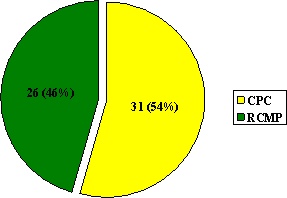
The number of complaint dispositions was further examined at the divisional level. The division mentioned most often in the complaint dispositions was "M" Division (49%), followed by "V" Division (30%) and "G" Division (21%). Of the 28 complaints received from "M" Division, 18 were lodged with the RCMP, while 10 were lodged with the Commission; of the 17 complaints received from "V" Division, 11 were lodged with the Commission and 6 were lodged with the RCMP; and of the 12 complaints received from "G" Division, 10 were lodged with the Commission and 2 were lodged with the RCMP.
The Territories: Number of Complaints by Division

The average number of members named in the complaints for the Territories was 1.5, with the rank of constable (65%) and corporal (26%) represented most often in the complaints.
The Territories: Number of Complaints by Member Rank
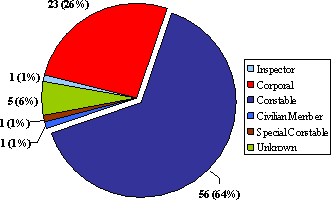
Allegations
A total of 148 allegations were made against members in the Territories, which averaged about 2.6 allegations per complaint. The most common allegation was "Improper Use of Force", followed by "Improper Attitude" and "Oppressive Conduct".
The Territories: Allegations Breakdown
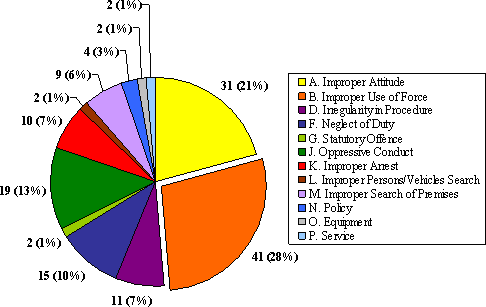
Allegations were further analyzed by member rank. For the Territories, constables were typically subjected to allegations of "Improper Use of Force" (26%) and "Improper Attitude" (23%), and corporals were most often subjected to allegations of "Improper Use of Force" (36%) and "Improper Attitude" (21%).
For every complaint disposition received, the Commission analyzed the reason and incident details in order to identify issues related to the nature of the complaint. By cross-referencing these issues with the RCMP allegations, the Commission was able to identify key issues that come up for each allegation. The two most common issues that were raised in the complaints for the Territories were "Attitude" (17%), "Arrest" (12%) and "Police Physical Abuse" (11%).
The Territories: Commission-Identified Issues
| Division | |||||
|---|---|---|---|---|---|
| Commission-Identified Issue | G | M | V | Total | % |
| Aboriginal community | 1 | 1 | 0 | 2 | 1.3% |
| Abusive Language | 0 | 2 | 0 | 2 | 1.3% |
| Alcohol or Drugs (not impairment) | 1 | 0 | 0 | 1 | 0.7% |
| Arrest | 6 | 8 | 4 | 18 | 11.9% |
| Attitude | 5 | 17 | 4 | 26 | 17.2% |
| Care in Custody | 1 | 2 | 1 | 4 | 2.6% |
| Chemical Irritant | 1 | 1 | 1 | 3 | 2.0% |
| Child Custody | 0 | 1 | 0 | 1 | 0.7% |
| Civil Disputes/No Child | 1 | 0 | 0 | 1 | 0.7% |
| Criminal Investigation Quality (RCMP) | 3 | 3 | 1 | 7 | 4.6% |
| Detention | 1 | 5 | 1 | 7 | 4.6% |
| Entry of Premises | 3 | 3 | 3 | 9 | 6.0% |
| Impairment | 2 | 3 | 3 | 8 | 5.3% |
| Lethal Weapons | 0 | 1 | 0 | 1 | 0.7% |
| Lying under Oath | 0 | 1 | 0 | 1 | 0.7% |
| Medical Care | 1 | 1 | 1 | 3 | 2.0% |
| Mental Illness | 2 | 1 | 0 | 3 | 2.0% |
| Non-lethal weapons other than chemical irritants | 3 | 1 | 0 | 4 | 2.6% |
| Non-spousal, Non-child Assault Response | 2 | 1 | 1 | 4 | 2.6% |
| Non-spousal, Non-child Sexual Assault Response | 1 | 0 | 0 | 1 | 0.7% |
| Other (if necessary) | 0 | 1 | 0 | 1 | 0.7% |
| Police Physical Abuse | 5 | 6 | 5 | 16 | 10.6% |
| Policy | 1 | 0 | 0 | 1 | 0.7% |
| Property Mishandling | 0 | 2 | 0 | 2 | 1.3% |
| Public Complaint Process Quality (RCMP) | 1 | 0 | 0 | 1 | 0.7% |
| Release/Disclosure of Information | 0 | 0 | 1 | 1 | 0.7% |
| Restraints | 1 | 0 | 1 | 2 | 1.3% |
| Right to Counsel | 1 | 2 | 0 | 3 | 2.0% |
| Search | 0 | 1 | 2 | 3 | 2.0% |
| Seizure | 0 | 1 | 0 | 1 | 0.7% |
| Service | 1 | 1 | 3 | 5 | 3.3% |
| Spousal Abuse Response | 1 | 0 | 0 | 1 | 0.7% |
| Vehicular Incidents | 1 | 4 | 2 | 7 | 4.6% |
| Youth Interaction | 1 | 0 | 0 | 1 | 0.7% |
| Total | 47 | 70 | 34 | 151 | |
Further, the results revealed trends in the issues for each allegation. For the purpose of this analysis, the common issues will be reported for the three most frequently occurring allegations: "Improper Use of Force", "Improper Attitude" and "Oppressive Conduct".
- The main issues that arose for "Improper Use of Force" were "Police Physical Abuse" (21%) and "Arrest" (20%).
- For allegations of "Improper Attitude" the key issues were "Attitude" (33%) and "Police Physical Abuse" (13%).
- The main issues identified in complaints dealing with allegations of "Oppressive Conduct" included "Arrest" (14%) and "Attitude" (13%).
Disposition of Complaints
The Territories: Number of Complaints by Disposition Type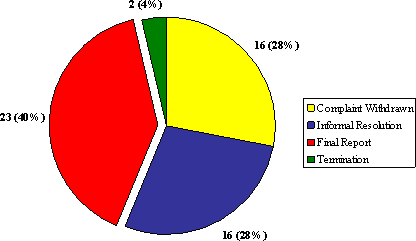
Investigation and Final Report
Of the complaint dispositions the Commission received from the Territories, 23 (40%) were formally investigated and a Final Report disposition was issued in the first instance by the RCMP. These reports made determinations on 69 allegations. The most common of these allegations were "Improper Use of Force" (33%), "Improper Attitude" (17%) and "Oppressive Conduct" (14%). Most of the RCMP's findings did not support the complainant's allegations (98%).
Informal Resolutions
Informal resolutions occurred in 28% of the cases, which dealt with 25 allegations. Allegations that were commonly subject to an informal resolution were "Improper Attitude", "Improper Use of Force" and "Irregularity in Procedure".
Withdrawals
In 28% of the dispositions received from the Territories, the complainant withdrew the complaint. A total of 46 allegations were disposed of in this manner. Allegations of "Improper Use of Force" and "Improper Attitude" commonly resulted in a withdrawal.
In all of the divisions in the Territories the percentage of dispositions that resulted in withdrawals was significantly higher than the Force-wide percentage; between 12-20 percentage points. This is a concern for the Commission, as there is evidence to suggest that public complaints are being improperly withdrawn and that informal resolutions are being erroneously captured as withdrawals on Form 4110s.
Terminations (Notice of Direction)38
In 2007, in 4% of the dispositions received from the Territories, a Notice of Direction was issued accounting for 8 allegations. Allegations that were subject to termination paragraphs included "Improper Attitude", "Improper Use of Force", "Statutory Offence" and "Improper Search of Premises". The grounds for termination most often invoked were paragraphs (b) and (c).
Service Standards: Complaint Processing Time
On average, it took 99 days to issue a disposition once the complaint was lodged (range: 1 to 333 days). This is in comparison to the RCMP national average of 114 days to issue a disposition once a complaint was lodged (range: 0 to 447 days). It typically took complainants in this division 115 days to lodge a complaint following the incident date (range: 0 to 2,166 days).
The Territories: Complaint Timeline Based on the Organization the Complaint Was Lodged With
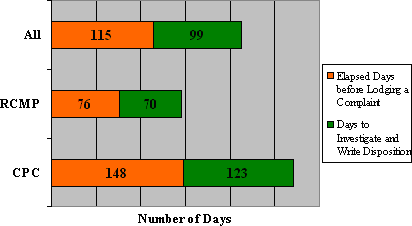
The average number of days to issue a complaint disposition was 123 for Commission-lodged complaints (range: 6 to 333 days) as opposed to 70 days for RCMP-lodged complaints (range: 1 to 241 days).
On average, complainants waited 148 days after the incident took place before lodging a complaint with the Commission (range: 0 to 2,166 days), while complaints lodged with the RCMP averaged only 76 days after the incident (range: 0 to 644 days).39
Independent of the public complaint processing timelines, the Review of the Record Project required the RCMP to provide the Commission copies of all dispositions for its analyses. To that end, the average number of days for the Commission to receive the complaint disposition from this division was 113 for Commission-lodged complaints (range: 7 to 365 days) as opposed to the 70 days for RCMP-lodged complaints (range: 6 to 224 days).
Complaint timelines were also determined by disposition type:
- It took 138 days to issue a Final Report by the RCMP (range: 43 to 333 days). For these cases, 200 days, on average, elapsed before a complainant lodged the original complaint (range: 1 to 2,166 days).
- It took 145 days to issue a Notice of Direction (range: 117 to 172 days). On average, 349 days elapsed before a complainant lodged the complaint in these cases (range: 53 to 644 days).
- On average, it took 86 days to complete a withdrawal (range: 1 to 304 days). On average, 37 days elapsed before a complainant lodged a complaint that was disposed of in this manner (range: 0 to 199 days).
- On average it took 48 days to enter into an informal resolution (range: 1 to 138 days). It took 43 days, on average, before a complainant lodged a complaint that was disposed of in this manner (range: 0 to 175 days).
The Territories: Number of Days to Issue the Disposition by Disposition Type
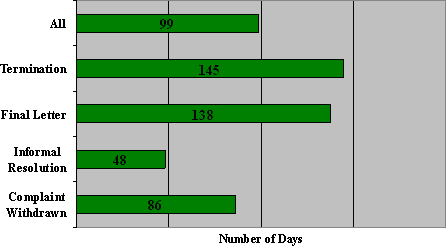
Complaint timelines were also determined by allegation type for the three most common allegations.
- For allegations of "Improper Use of Force", it took, on average, 138 days (range: 28 to 333 days) for the RCMP to issue a disposition. Typically, it took a complainant 177 days (range: 0 to 2,166 days) after the incident date to file a complaint for this type of allegation.
- For allegations of "Improper Attitude", it took, on average, 69 days (range: 1 to 197 days) for the RCMP to issue a disposition. Typically, it took a complainant 37 days (range: 0 to 175 days) following the incident date to lodge a complaint for this type of allegation.
- For allegations of "Oppressive Conduct", it took, on average, 132 days (range: 21 to 304 days) for the RCMP to issue a disposition. Typically, it took a complainant 349 days (range: 0 to 2,166 days) after the incident date to lodge a complaint for this type of allegation.
A-National Capital Region
Complaints Received
The Commission received 16 complaint dispositions from "A" Division, of which 10 (62.5%) were lodged with the Commission, while6 (37.5%) were lodged with the RCMP. The vast majority of complaints (69%) identified Headquarters-Ottawa as the incident detachment.
"A" Division: Number of Complaints
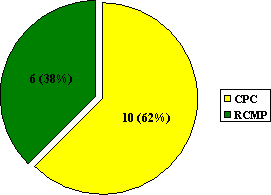
The average number of members named in the complaint for "A" Division was 1; with constables (53%) being the rank most represented in the complaints. The rank of chief superintendent was represented in 20% of the complaints, while the RCMP Commissioner was the subject of 2 complaints.
"A" Division: Ranks Represented in Complaints
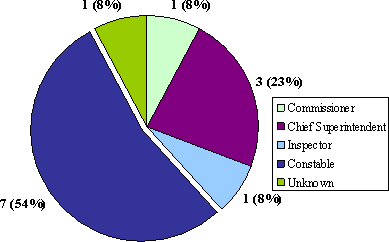
Allegations
A total of 15 allegations were made against members in "A" Division, which averaged about 0.940 allegations per complaint. The two most common allegations were "Irregularity in Procedure" (40%) and "Oppressive Conduct" (20%).
"A" Division: Allegations Breakdow
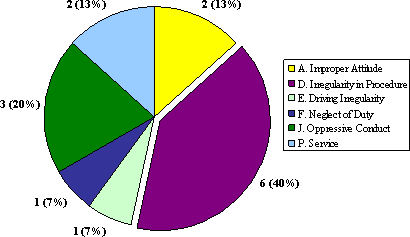
Allegations of "Improper Attitude" (33%) and "Irregularity in Procedure" (33%) were most commonly directed towards constables. Likewise, the most common (and only) allegation against inspectors was "Irregularity in Procedure" (100%). Of the 3 allegations made against the chief superintendent, 2 (67%) were related to "Oppressive Conduct".
For every complaint disposition received, the Commission analyzed the reason and incident details in order to identify issues related to the nature of the complaint. By cross-referencing these issues with the RCMP allegations, the Commission was able to identify key issues that come up for each allegation. The two most common issues that were raised in the complaints were "Criminal Investigation Quality" (26%) and "Attitude" (17%).
| Issue | Number of Complaints | % |
|---|---|---|
| Abusive Language | 2 | 8.7% |
| Attitude | 4 | 17.4% |
| Conflict of Interest | 2 | 8.7% |
| Criminal Investigation Quality (RCMP) | 6 | 26.1% |
| Entry of Premises | 1 | 4.3% |
| Non-pursuit Police Driving | 1 | 4.3% |
| Policy | 2 | 8.7% |
| Public Complaint Process Quality (RCMP) | 1 | 4.3% |
| Release/Disclosure of Information | 2 | 8.7% |
| Service | 2 | 8.7% |
| Total | 23 |
Further, the results revealed trends in the issues for each allegation. For the purpose of this analysis, the common issues will be reported for the two most frequently occurring allegations: "Irregularity in Procedure" and "Oppressive Conduct". For complaints alleging "Irregularity in Procedure" the key issue was "Criminal Investigation Quality (RCMP)" (30%). The only issue raised for "Oppressive Conduct" was also "Criminal Investigation Quality (RCMP)" (100%).
Disposition of Complaints
"A" Division: Number of Complaints by Disposition Type
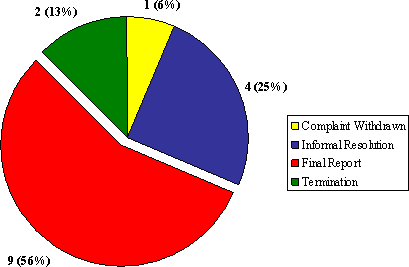
Investigation and Final Report
Of the complaint dispositions the Commission received, 56% were formally investigated and a Final Report by the RCMP was issued. These reports made determinations on 9 allegations. The allegation for which a Final Report by the RCMP was most commonly issued was "Irregularity in Procedure". Interestingly, the RCMP's findings did not support any of the complainant's allegation(s).
Informal Resolutions
Accounting for the second most common way to dispose of a complaint, informal resolutions occurred in 25% of the cases, which represented 3 allegations. The allegation that was most likely to result in an informal resolution was "Improper Attitude".
Withdrawals
In one case (6%) the complainant withdrew the complaint, which related to an allegation of "Irregularity in Procedure".
Terminations (Notice of Direction)41
On average, 13% of the complaint dispositions were disposed of through a Notice of Direction, which represented 2 allegations. Those allegations were "Irregularity in Procedure" and "Oppressive Conduct". In one case the termination paragraph was not specified and in another the investigation was terminated under paragraph (a).
Service Standards: Complaint Processing Time
On average, this division took 137 days to issue any type of disposition once a complaint was lodged (range: 14 to 369 days). This is in comparison to the RCMP national average of 114 days to issue a disposition once a complaint was lodged (range: 0 to 447 days). It typically took almost two years (693 days) for a complainant to lodge a complaint (range: 0 to 4,264 days).
"A" Division: Complaint Timeline Based on the Organization the Complaint Was Lodged With
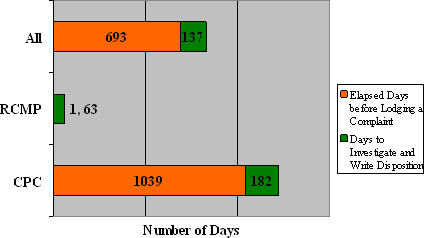
The average number of days to issue a disposition was 182 days for Commission-lodged complaints (range: 41 to 369 days) as opposed to 63 days for RCMP-lodged complaints (range: 14 to 253 days). On average, complainants waited 1,039 days after the incident took place before lodging a complaint with the Commission (range: 1 to 4,264 days), while complaints lodged with the RCMP averaged only 1 day after the incident (range from 0 to 5 days).42
Independent of the public complaint processing timelines, the Review of the Record Project required the RCMP to provide the Commission copies of all dispositions for its analyses. To that end, the average number of days for the Commission to receive the complaint disposition from this division was 85 for Commission-lodged complaints (range: 10 to 164 days) as opposed to the 65 days it took for RCMP-lodged complaints (range: 3 to 104 days).
The Ottawa-Headquarters Detachment took 127 days to issue a disposition once a complaint was lodged (range: 20 to 369 days). Typically, complainants waited 515 days after the incident date to lodge a complaint against members in this detachment (range: 0 to 4,264 days).
Complaint timelines were also determined by disposition type:
- It took 219 days to issue a Final Report by the RCMP (range: 85 to 369 days). For these cases, on average, 1,051 days elapsed before a complainant lodged the original complaint (range: 0 to 4,264 days).
- It took 50 days to issue a Notice of Direction (range: 41 to 59 days). On average, it took 463 days to elapse before a complainant lodged the original complaint (range: 1 to 925 days).
- On average, it took 20 days to complete a withdrawal. For these cases, it took 5 days to elapse before a complainant lodged the original complaint that was subsequently disposed of in this manner.
- On average it took 27 days to enter into an informal resolution (range: 14 to 38 days). For these cases, it took 1 day to elapse before a complainant lodged the original complaint that was disposed of in this manner (range: 0 to 2 days).
"A" Division: Number of Days to Issue the Disposition by Disposition Type
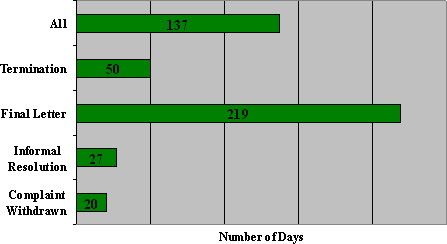
Complaint timelines were also determined for the two most common allegation types.
- Allegations of "Irregularity in Procedure", on average, took 134 days for a disposition to be issued (range: 20 to 369 days). Typically, complainants waited 81 days after the incident date to lodge a complaint (range: 1 to 403 days) for this type of allegation.
- Allegations of "Oppressive Conduct" took, on average, 175 days for a disposition to be issued (range: 41 to 262 days) for this type of allegation. Complainants lodged a complaint, on average, 3,151 days after the incident date (range: 925 to 4,264 days).
B-Newfoundland and Labrador
Complaints Received
The Commission received 41 complaint dispositions related to complaints lodged in 2007. The complaint dispositions were further examined at the detachment level. The detachments identified most often in the complaint dispositions included the Happy Valley-Goose Bay Detachment (20%), followed by the Lewisporte Detachment (12%), the Trinity-Conception Detachment (12%) and the Corner Brook S/Div. Headquarters (12%). Of the 41 complaints received from "B" Division, 21 (51%) were lodged with the RCMP, while 20 (49%) were lodged with the Commission.
"B" Division: Number of Complaints Based on the Organization it Was Lodged With
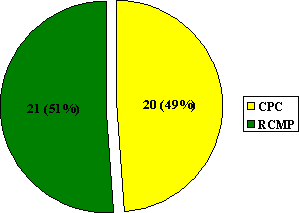
The average number of members named in the complaint for "B" Division was 2.3 with constables (56%) being the rank most represented in the complaints followed by corporals (23%). Sergeants were represented in 10% of the complaints.
"B" Division: Number of Complaints by Member Rank
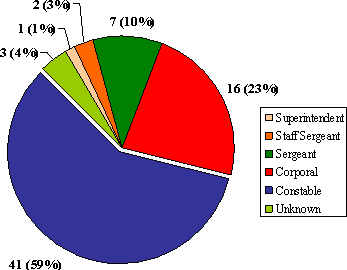
Allegations
A total of 107 allegations were made, which averaged about 2.6 allegations per complaint. The three most common allegations were "Neglect of Duty" (32%), "Improper Attitude" (18%) and "Improper Use of Force" (13%). Allegations were also examined at the detachment level.
"B" Division: Allegations Breakdown
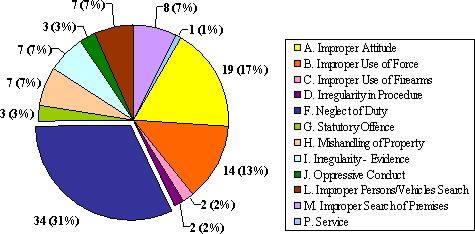
For the Trinity-Conception Detachment, the results indicate that the most common allegations pertained to "Improper Use of Force" (25%), "Mishandling of Property" (25%) and "Improper Persons/Vehicles Search" (25%). The most common types of allegations for the Corner Brook S/Div. Headquarters Detachment were "Neglect of Duty" (33%) and "Improper Search of Premises" (33%). For the Happy Valley-Goose Bay Detachment the most frequent allegation was "Neglect of Duty" (62%). Finally, the most common type of allegation for the Lewisporte Detachment was "Improper Attitude" (39%).
Allegations were further analyzed by member rank. Allegations of "Neglect of Duty" were the most common allegation directed towards sergeants (67%), corporals (24%) and constable (28%). Gender differences were also observed by allegation type.
Allegations were also analyzed by disposition type. For complaints involving allegations of "Neglect of Duty", it was common for the RCMP to issue a Final Report (59%), while for "Improper Attitude" the most common disposition was an informal resolution (42%). Allegations of "Improper Use of Force" were either issued a Final Report (50%) or the complaint was withdrawn by the complainant (50%).
For every complaint disposition received, the Commission analyzed the reason and incident details in order to identify issues related to the nature of the complaint. By cross-referencing these issues with the RCMP allegations, the Commission was able to identify key issues that come up for each allegation. The most common issues that were raised in the complaints for this division were "Criminal Investigation Quality (RCMP)" (19%), "Attitude" (17%), "Arrest" (7%), and "Public Complaint Process Quality (RCMP)" (6%). In comparing the issues raised for the three most frequent allegations, it appears that there is a common perceived lack of police professionalism as well as complainant dissatisfaction with the way criminal investigations were handled by the RCMP, as these were prominent issues identified in most of the allegations mentioned above.
| Issue | Number of Complaints | % |
|---|---|---|
| Abusive Language | 4 | 3.9% |
| Alcohol or Drugs (not impairment) | 4 | 3.9% |
| Arrest | 7 | 6.8% |
| Attitude | 17 | 16.5% |
| Care in Custody | 1 | 1.0% |
| Child Abuse Response | 1 | 1.0% |
| Civil Disputes/No Child | 0 | 0.0% |
| Criminal Investigation Quality (RCMP) | 20 | 19.4% |
| Crowd Control | 0 | 0.0% |
| Detention | 3 | 2.9% |
| Entry of Premises | 2 | 1.9% |
| Lying under Oath | 3 | 2.9% |
| Lethal Weapons | 0 | 0.0% |
| Medical Care | 1 | 1.0% |
| Mental Illness | 1 | 1.0% |
| Non-lethal weapons other than chemical irritants | 1 | 1.0% |
| Non-pursuit Police Driving | 0 | 0.0% |
| Non-spousal, Non-child Assault Response | 2 | 1.9% |
| Non-spousal, Non-child Sexual Assault Response | 1 | 1.0% |
| Other (if necessary) | 2 | 1.9% |
| Police Dogs | 0 | 0.0% |
| Police Physical Abuse | 3 | 2.9% |
| Police Pursuit Driving | 0 | 0.0% |
| Policy | 2 | 1.9% |
| Property Mishandling | 0 | 0.0% |
| Public Complaint Process Quality (RCMP) | 6 | 5.8% |
| Release/Disclosure of Information | 1 | 1.0% |
| Restraints | 0 | 0.0% |
| Right to Counsel | 2 | 1.9% |
| Search | 5 | 4.9% |
| Seizure | 3 | 2.9% |
| Service | 3 | 2.9% |
| Vehicular Incidents | 4 | 3.9% |
| Youth Interaction | 4 | 3.9% |
| Total | 103 |
Disposition of Complaints
"B" Division: Number of Complaints by Disposition Type
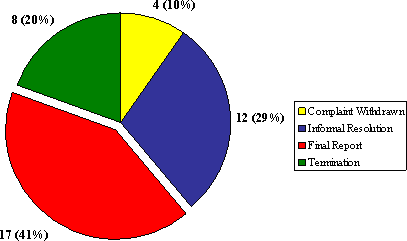
Investigation and Final Report
Of the complaint dispositions the Commission received, 42% were formally investigated and a Final Report by the RCMP issued. These reports made determinations on 50 allegations, the most common allegation being "Neglect of Duty".
For almost every type of allegation, with the exception of "Improper Attitude", none of the complainant's allegations were supported. For allegations of "Improper Attitude", 57% of the RCMP's findings supported the allegation(s) while 43% of the findings did not support the complainant's allegation(s).
Informal Resolutions
Accounting for the second most common way to dispose of a complaint, informal resolutions occurred in 29% of the cases; addressing 16 allegations. Allegations most likely to end in an informal resolution were "Improper Attitude" and "Neglect of Duty".
Withdrawals
In 10% of the cases, the complainant withdrew the complaint. Withdrawals disposed of 25 allegations, the most common of which were "Improper Use of Force", "Mishandling of Property" and "Improper Persons/Vehicles Search".
Terminations (Notice of Direction)43
In 2007, in 20% of all the dispositions received from "B" Division, a Notice of Direction was issued, accounting for 15 allegations. In 50% of the 8 complaint dispositions, the termination paragraph was not specified in the Notice of Direction. Allegations of "Neglect of Duty" and "Improper Search of Premises" were most often terminated. Further, in most cases, the specific legislative grounds for termination were not specified.
"B" Division: Number of Terminated Complaints by Grounds Identified in subsection 45.36(5) of the RCMP Act
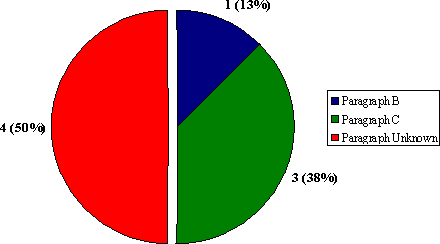
Service Standards: Complaint Processing Time
On average, it took 99 days to issue a disposition once a complaint was lodged (range: 0 to 318 days). This is in comparison to the RCMP national average of 114 days to issue a disposition once a complaint was lodged (range: 0 to 447 days). It typically took close to one year (341 days) to elapse before a complainant lodged the original complaint (range: 0 to 3,706 days).
"B" Division: Complaint Timeline Based on the Organization the Complaint Was Lodged With
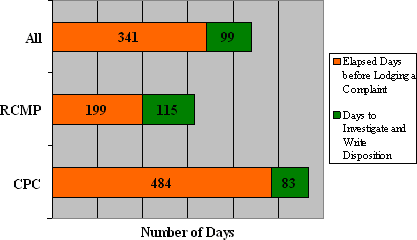
The average number of days to issue a disposition was 83 for Commission-lodged complaints (range: 13 to 276 days) as opposed to 115 days for RCMP-lodged complaints (range: 0 to 318 days).
On average, complainants waited 484 days after the incident took place before lodging a complaint with the Commission (range: 0 to 3,706 days), while complaints lodged with the RCMP averaged 199 days after the incident (range: 1 to 1,942 days).44
Independent of the public complaint processing timelines, the Review of the Record Project required the RCMP to provide the Commission copies of all dispositions for its analyses. To that end, the average number of days for the Commission to receive the complaint disposition from this division was 42 for Commission-lodged complaints (range: 7 to 180 days) as opposed to the 93 days it took for RCMP-lodged complaints (range: 11 to 249 days).
Complaint processing times were analyzed for each of the four detachments in "B" Division with the most complaint dispositions:
- The Trinity-Conception Detachment took 123 days to issue a disposition once a complaint was lodged (range: 31 to 318 days). On average, complainants waited 793 days after the incident took place before lodging a complaint (range: 2 to 1,660 days).
- The Corner Brook S/Division Headquarters Detachment took an average of 88 days to issue a disposition once a complaint was lodged (range: 0 to 184 days). On average, complainants waited 990 days after the incident took place before lodging a complaint (range: 7 to 3,706 days).
- The Happy Valley-Goose Bay Detachment took an average of 73 days to issue a disposition (range: 19 to 169 days). On average, complainants waited 165 days after the incident took place before lodging a complaint (range: 0 to 1,249 days).
- The Lewisporte Detachment took on average 91 days to issue a disposition for a public complaint (range: 14 to 143 days) On average, complainants waited 48 days after the incident took place before lodging a complaint (range: 1 to 183 days).
Complaint timelines were also determined by disposition type:
- To issue a Final Report it took "B" Division on average 176 days (range: 66 to 318 days). For these cases, it generally took 339 days for a complainant to lodge the original complaint that resulted in this type of disposition (range: 5 to 1,942 days).
- To issue an informal resolution it took an average of 35 days to issue a disposition (range: 0 to 101 days). For these cases, 57 days, on average, elapsed before a complainant lodged the original complaint that resulted in this type of disposition (range: 1 to 461 days).
- To issue a Notice of Direction, invoking any provision, it took 36 days (range: 19 to 50 days). For these cases, it generally took 860 days for a complainant to lodge the original complaint that resulted in this type of disposition (range: 0 to 3,706 days).
- For withdrawals it took on average 93 days to complete this type of disposition (range: 73 to 115 days). For these cases, it generally took 114 days to elapse before a complainant lodged the original complaint that resulted in this type of disposition (range: 2 to 246 days).
"B" Division: Number of Days to Issue the Disposition by Disposition Type
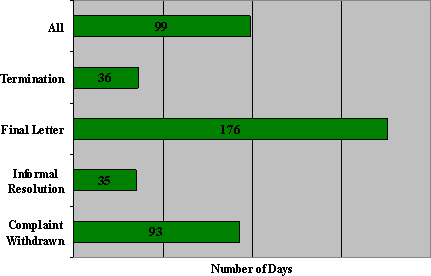
Complaint timelines could be determined by allegation type. For the three most common types of allegations, i.e. "Neglect of Duty" (32%), "Improper Attitude" (18%) and "Improper Use of Force" (13%) timelines are reported.
- Allegations of "Neglect of Duty", on average, took 120 days for a disposition to be issued (range from 13 to 318 days). Typically, complainants waited 483 days after the incident date to lodge a complaint (range from 0 to 3,706 days) for this type of allegation.
- Allegations of "Improper Attitude", on average, took 96 days for a disposition to be issued (range from 0 to 276 days). Complainants, on average, lodged a complaint 38 days after the incident date (range from 0 to 246 days) for this type of allegation.
- Allegations of "Improper Use of Force" took 158 days for a disposition to be issued once a complaint was lodged (range from 115 to 184 days). On average, complainants waited 79 days to lodge a complaint (range from 6 to 252 days) for this type of allegation.
It is interesting to note that within "B" Division complaints involving "Improper Use of Firearms" allegations, on average, took the longest time (180 days) to issue dispositions suggesting that these types of concerns might require more detailed and lengthy investigations. This interpretation may be supported by the finding that complaints involving this type of allegation were issued a Final Report in all cases.
C-Quebec
Complaints Received
The Commission received 24 complaint dispositions of which half (50%) were lodged with the Commission and the other half (50%) were lodged with the RCMP. The number of complaint dispositions was further examined at the detachment level. "C" Division Headquarters had more complaints lodged with the Commission (83%) than the RCMP (17%), while the Montreal Sub Division Detachments had more complaints lodged with the RCMP (60%) than the Commission (40%).
"C" Division: Number of Complaints Based on the Organization it Was Lodged With
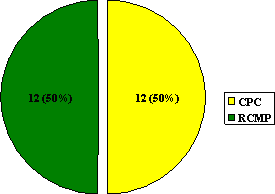
The average number of members named in the complaints was 1.3. Most of the members (37%) identified in the complaints were not categorized by rank. Interestingly, the second most frequently occurring ranks of the subject members were corporals (19%) and sergeants (19%). Given that most front-line policing within the RCMP is done by constables and corporals, it is surprising that as many sergeants as corporals were represented in the complaint dispositions from "C" Division. However, it is possible that more constables and corporals are represented in the "Unknown" member rank category.
"C" Division: Number of Complaints by Member Rank
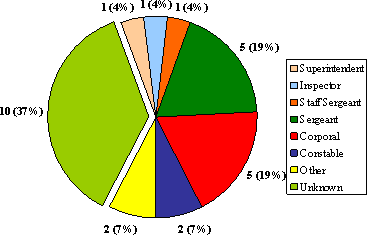
Allegations
A total of 47 allegations were made, which averaged about 2 allegations per complaint. The 2 most common allegations were "Improper Attitude" (36%) and "Neglect of Duty" (36%).
"C" Division: Allegations Breakdown
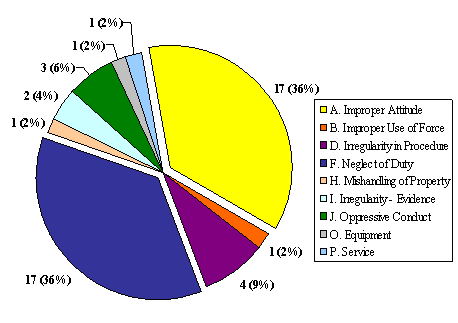
In "C" Division, "Neglect of Duty" was a common allegation across most of the member ranks represented in the complaints. "Improper Attitude" (50%) was the most common allegations for constables, while complainants were most likely to make allegations of "Neglect of Duty" (80%) against corporals.
For every complaint disposition received, the Commission analyzed the reason and incident details in order to identify issues related to the nature of the complaint. By cross-referencing these issues with the RCMP allegations, the Commission was able to identify key issues that come up for each allegation. The four most common issues that were raised in the complaints for "C" Division were "Attitude" (25%), "Criminal Investigation Quality" (10%), "Crowd Control" (10%) and "Service" (10%).
| Issue | Number of Complaints | % |
|---|---|---|
| Alcohol or Drugs (not impairment) | 1 | 2.0% |
| Arrest | 3 | 6.1% |
| Attitude | 12 | 24.5% |
| Chemical Irritant | 1 | 2.0% |
| Criminal Investigation Quality (RCMP) | 5 | 10.2% |
| Crowd Control | 5 | 10.2% |
| Entry of Premises | 1 | 2.0% |
| Impairment | 1 | 2.0% |
| Informants/Sources | 2 | 4.1% |
| Lying under Oath | 1 | 2.0% |
| Mental Illness | 3 | 6.1% |
| Police Physical Abuse | 3 | 6.1% |
| Policy | 1 | 2.0% |
| Public Complaint Process Quality (RCMP) | 1 | 2.0% |
| Release/Disclosure of Information | 1 | 2.0% |
| Search | 1 | 2.0% |
| Seizure | 1 | 2.0% |
| Service | 5 | 10.2% |
| Vehicular Incidents | 1 | 2.0% |
| Total | 49 |
Further, the results revealed trends in the issues for each allegation. For the purpose of this analysis, the common issues will be reported for the two most frequently occurring allegations: "Improper Attitude" and "Neglect of Duty". For complaints alleging "Improper Attitude" the key issues were "Attitude" (37%), "Crowd Control" (12%) and "Police Physical Abuse" (12%). The main issues for "Neglect of Duty" included "Service" (27%), "Criminal Investigation Quality" (23%) and "Alcohol or Drugs (not impairment)" (14%).
Disposition of Complaints
"C" Division: Number of Complaints by Disposition Type
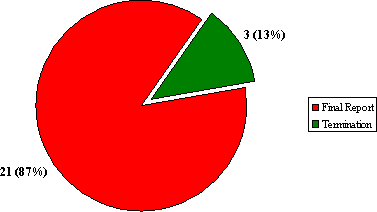
Investigation and Final Report
Of the complaint dispositions the Commission received, 88% were formally investigated and a Final Report by the RCMP issued. These reports made determinations on 42 allegations, of which none were supported by the RCMP. The Force-wide percentage of dispositions that resulted in a Final Report by the RCMP was 46%; Final Reports in "C" Division accounted for 88% of complaint dispositions, which was significantly higher than the Force-wide average.
Allegations most likely to result in a Final Report were "Improper Attitude" and "Neglect of Duty".
Informal Resolutions
None of the complaint dispositions received by the Commission for this Division documented an informal resolution.
Withdrawals
None of the complaint dispositions received by the Commission contained a complaint withdrawal.
Terminations (Notice of Direction)45
In 2007, on average, in 13% of the dispositions received, a Notice of Direction was issued. Interestingly, in all three cases, termination paragraph (c) was cited in the Notice of Direction. The allegation most likely to be subjected to a termination paragraph was "Oppressive Conduct".
Service Standards: Complaint Processing Time
On average, it took 130 days for the division to issue a disposition once a complaint was lodged (range: 1 to 360 days). This is in comparison to the RCMP national average of 114 days to issue a disposition once a complaint was lodged (range: 0 to 447 days). It typically took 525 days for a complainant to lodge a complaint (range: 1 to 2,695 days).
"C" Division: Complaint Timeline Based on the Organization the Complaint Was Lodged With
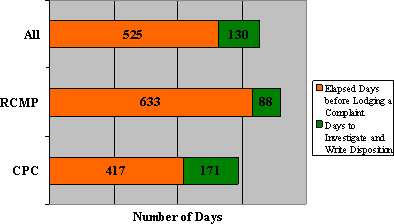
The average number of days to issue a disposition was 171 for Commission-lodged complaints (range: 82 to 360 days) as opposed to 88 days for RCMP-lodged complaints (range: 1 to 273 days). On average, complainants waited 417 days after the incident took place before lodging a complaint with the Commission (range: 2 to 2,619 days), while complaints lodged with the RCMP averaged 633 days after the incident (range: 1 to 2,695 days).46
Independent of the public complaint processing timelines, the Review of the Record Project required the RCMP to provide the Commission copies of all dispositions for its analyses. To that end, the average number of days for the Commission to receive the complaint disposition from this Division was 31 for Commission-lodged complaints (range: 8 to 147 days) as opposed to the 50 days it took for RCMP-lodged complaints (range: 3 to 174 days).
"C" Division Headquarters took, on average, 130 days to issue a disposition (range: 1 to 167 days). In general, complainants waited 347 days after the incident date to lodge a complaint (range: 2 to 1,528 days).
Complaint timelines were also determined by disposition type:
- It took, on average, 143 days to issue a Final Report (range: 13 to 360 days). For these cases it generally took 399 days to elapse before a complainant lodged a complaint that resulted in this type of disposition (range: 1 to 2,619 days).
- It took 37 days for a Notice of Direction to be issued (range: 1 to 94 days). It generally took 1,410 days to elapse before a complainant lodged a complaint that resulted in this type of disposition (range: 6 to 2,695 days).
"C" Division: Number of Days to Issue the Disposition by Disposition Type
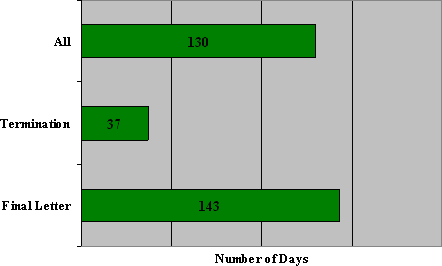
Complaint timelines were also determined by allegation type. Timelines are reported for the 2 most common types of allegations: "Improper Attitude" and "Neglect of Duty".
- Allegations of "Improper Attitude", on average, took 122 days for a disposition to be issued (range: 16 to 273 days). Typically, complainants waited 400 days after the incident date to lodge a complaint (range: 1 to 2695 days) with this type of allegation.
- Allegations of "Neglect of Duty", on average, took 159 days for a disposition to be issued (range: 16 to 360 days). Complainants lodged a complaint, on average, 795 days after the incident date for this type of allegation (range: 3 to 2,695 days) with this type of allegation.
It is interesting to note that within "C" Division complaints involving "Irregularity in Evidence" allegations, on average, took the longest time (180 days) to issue dispositions.
D-Manitoba
Complaints Received
The Commission received 113 complaint dispositions of which 74% were lodged with the Commission, while 26% were lodged with the RCMP.
"D" Division: Number of Complaints Based on the Organization it Was Lodged With
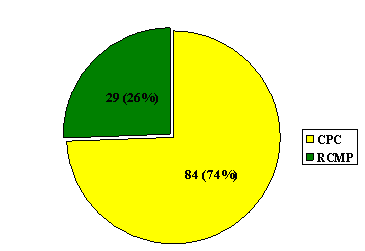
The complaint dispositions were further examined at the detachment level. The detachments47 identified most often in the complaint dispositions included Selkirk (10%), Steinbach (8%) and Thompson (7%). In comparing the three detachments, it was found that:
- For the Selkirk Detachment, 5 (71%) of the complaints were lodged with the Commission, while 2 (29%) were lodged with the RCMP.
- For the Steinbach Detachment, 4 (67%) of the complaints were lodged with the Commission and 2 (33%) were lodged with the RCMP.
- For the Thompson Detachment, 3 (60%) of the complaints were lodged with the Commission, while 2 (40%) were lodged with the RCMP.
The average number of members named in the complaints for "D" Division was 1.8 with the rank of constable (51%) being the most frequently represented rank in the complaints, followed by the ranks of corporal (28%) and sergeant (5%).
"D" Division: Number of Complaints by Member Rank
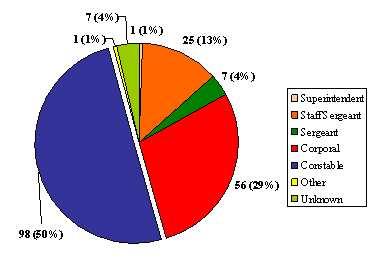
Allegations
A total of 280 allegations were made against members in "D" Division, which averaged about 2.5 allegations per complaint. The two most common allegations were "Neglect of Duty" (32%) and "Statutory Offence" (24%).
"D" Division: Allegations Breakdown
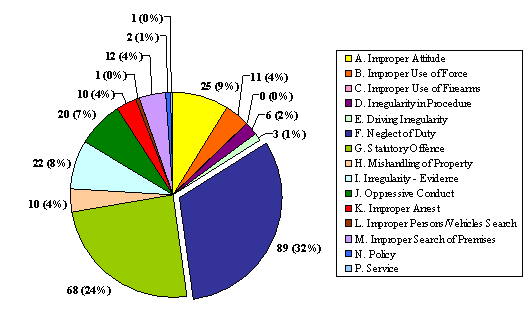
Allegations were also examined at the detachment level. "Neglect of Duty" was the most common of the allegations cited in the complaint dispositions received from all of the detachments: Selkirk Detachment (82%), Steinbach Detachment (60%) and Thompson Detachment (42%).
Allegations were further analyzed by member rank. In "D" Division, "Neglect of Duty" was the most common allegation against constables (39%), while corporals (34%) and staff sergeants (44%) were typically the subject of allegations of "Statutory Offence".
For every complaint disposition received, the Commission analyzed the reason and incident details in order to identify issues related to the nature of the complaint. By cross-referencing these issues with the RCMP allegations, the Commission was able to identify key issues that come up for each allegation. The most common issues raised in the complaints for "D" Division were "Criminal Investigation Quality (RCMP)" (18%), "Attitude" (8%), "Arrest" (8%), "Lying Under Oath" (7%), "Seizure" (6%) and "Service" (6%).
| Issue | Number of Complaints | % |
|---|---|---|
| Aboriginal community | 5 | 1.8% |
| Abusive Language | 2 | 0.7% |
| Alcohol or Drugs (not impairment) | 4 | 1.5% |
| Arrest | 21 | 7.7% |
| Attitude | 23 | 8.4% |
| Care in Custody | 6 | 2.2% |
| Child Abuse Response | 1 | 0.4% |
| Child Custody | 3 | 1.1% |
| Civil Disputes/No Child | 1 | 0.4% |
| Conflict of Interest | 1 | 0.4% |
| Criminal Investigation Quality (RCMP) | 50 | 18.2% |
| Detention | 12 | 4.4% |
| Entry of Premises | 2 | 0.7% |
| Impairment | 5 | 1.8% |
| Informants/Sources | 1 | 0.4% |
| Lethal Weapons | 3 | 1.1% |
| Lying under Oath | 18 | 6.6% |
| Medical Care | 4 | 1.5% |
| Mental Illness | 6 | 2.2% |
| Non-lethal weapons other than chemical irritants | 3 | 1.1% |
| Non-pursuit Police Driving | 2 | 0.7% |
| Non-spousal, Non-child Assault Response | 6 | 2.2% |
| Non-spousal, Non-child Sexual Assault Response | 5 | 1.8% |
| Note-taking Quality | 1 | 0.4% |
| Police Physical Abuse | 6 | 2.2% |
| Policy | 2 | 0.7% |
| Property Mishandling | 11 | 4.0% |
| Public Complaint Process Quality (RCMP) | 6 | 2.2% |
| Release/Disclosure of Information | 2 | 0.7% |
| Restraints | 1 | 0.4% |
| Right to Counsel | 6 | 2.2% |
| Search | 9 | 3.3% |
| Seizure | 17 | 6.2% |
| Service | 15 | 5.5% |
| Spousal Abuse Response | 6 | 2.2% |
| Vehicular Incidents | 7 | 2.6% |
| Youth Interaction | 1 | 0.4% |
| Total | 274 |
Further, the results revealed trends in the issues for each allegation. For the purpose of this analysis, the common issues will be reported for the two most frequently occurring allegations: "Neglect of Duty" and "Statutory Offence". For complaints involving allegations of "Neglect of Duty" the key issues were "Criminal Investigation Quality (RCMP)" (24%), "Service" (8%), "Arrest" (7%) and "Attitude" (65%). For allegations of "Statutory Offence" the prominent issues that were identified included "Criminal Investigation Quality" (26%), "Lying Under Oath" (19%), "Seizure" (10%), "Arrest" (8%) and "Detention" (6%). In comparing the issues raised for the most common allegations, it appears that there is a common perceived dissatisfaction with the way the RCMP members conduct criminal investigations as well as the way members conduct themselves during arrests, as these were prominent issue identified in all three allegations.
Disposition of Complaints
"D" Division: Number of Complaints by Disposition Type
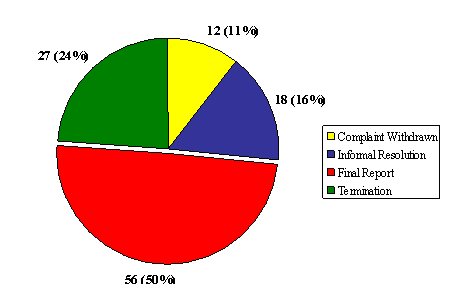
Investigation and Final Report
Of the complaint dispositions the Commission received, 56 (50%) were formally investigated and a Final Report by the RCMP issued. These reports made determinations on 164 allegations. For almost every type of allegation, with the exception of "Driving Irregularity", the overwhelming majority (78-100%) of the RCMP's findings did not support the complainant's allegation(s).
Allegations most likely to be subject to a Final Report were "Neglect of Duty", "Statutory Offence" and "Irregularity – Evidence."
Informal Resolutions
Informal resolutions occurred in 16% of the complaint dispositions received, which dealt with 28 allegations. The allegation most likely to be informally resolved was "Neglect of Duty".
Withdrawals
In 11% of the cases, the complainant withdrew the complaint, which disposed of 19 allegations. The allegation most likely to be withdrawn was "Neglect of Duty".
Terminations (Notice of Direction)48
In 24% of all public complaints received, a Notice of Direction was issued, which dealt with 69 allegations. In 93% of the 27 cases, termination paragraph (c) was cited in the Notice of Direction. In the remaining 2 cases (7%), termination paragraph (b) was provided as rationale for the termination in the Notice of Direction.
The Force-wide percentage of dispositions that were Notice of Directions was 11%. Notice of Directions accounted for 24% of "D" Division dispositions, which is significantly higher than the Force-wide percentage. However, this discrepancy could be explained by the multiple complaints lodged by one complainant, which have been repeatedly terminated by the RCMP.
The allegation most likely to be subject to a Notice of Direction in this division was "Statutory Offence".
"D" Division: Number of Terminated Complaints by Grounds Identified in subsection 45.36(5) of the RCMP Act
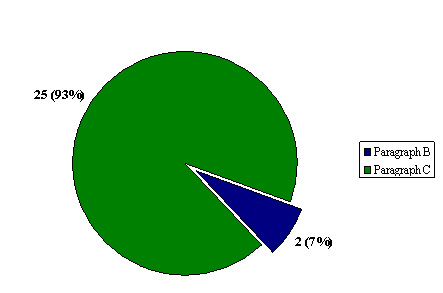
Service Standards: Complaint Processing Time
"D" Division, on average, took 100 days to issue a disposition once a complaint was lodged (range: 0 to 323 days). This is in comparison to the RCMP national average of 114 days to issue a disposition once a complaint was lodged (range: 0 to 447 days). It typically took close to one year (316 days) for a complainant to lodge a complaint (range: 0 to 1,518 days).
"D" Division: Complaint Timeline by Organization it Was Lodged With
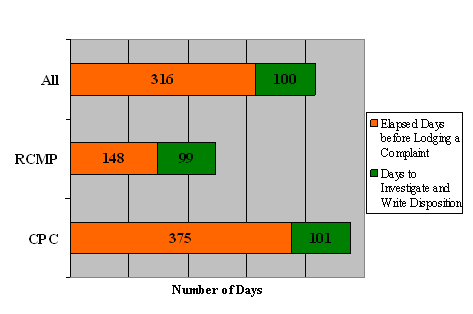
The average number of days to issue a disposition was 101 for Commission-lodged complaints (range: 18 to 323 days) as opposed to 99 days for RCMP-lodged complaints (range: 0 to 278 days). On average, complainants waited 375 days after the incident took place before lodging a complaint with the Commission (range: 0 to 1,518 days), while complaints lodged with the RCMP averaged 148 days after the incident (range: 0 to 917 days).49
Independent of the public complaint processing timelines, the Review of the Record Project required the RCMP to provide the Commission copies of all dispositions for its analyses. To that end, the average number of days for the Commission to receive the complaint disposition from this division was 130 for Commission-lodged complaints (range: 24 to 290 days) and 130 days for RCMP-lodged complaints (range: 18 to 249 days).
Complaint timelines were also determined by disposition type.
- To issue a Final Report by the RCMP it took an average of 132 days to issue a disposition (range: 27 to 278 days). For these cases it generally took 253 days to elapse before a complainant lodged a complaint that resulted in this type of disposition (range: 0 to 962 days).
- To issue a Notice of Direction, invoking any termination provisions, it took 74 days (range: 19 to 228 days). It generally took 711 days to elapse before a complainant lodged a complaint that resulted in this type of disposition (range: 0 to 1,518 days).
- To enter into an informal resolution it took 62 days (range: 0 to 272 days). It generally took 105 days to elapse before a complainant lodged a complaint that resulted in this type of disposition (range: 0 to 1,069 days).
- To withdraw a complaint it took 71 days to complete (range: 7 to 323 days). It generally took 26 days to elapse before a complainant lodged a complaint that resulted in this type of disposition (range: 0 to 111 days).
"D" Division: Number of Days to Issue the Disposition by Disposition Type
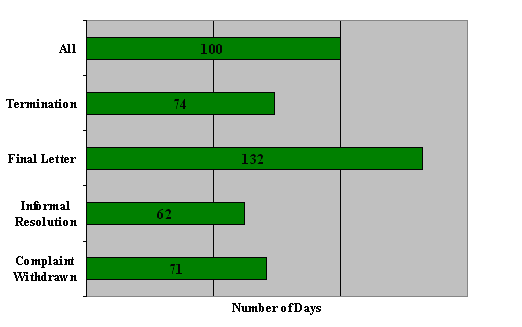
Complaint timelines were also determined by allegation type. For the two most common types of allegations, i.e. "Neglect of Duty" and "Statutory Offence", timelines are reported.
- Allegations of "Neglect of Duty", on average, took 104 days for a disposition to be issued (range: 7 to 323 days. Typically, complainants waited close to a year (301 days) after the incident date to lodge a complaint (range: 0 to 1,518 days) for this type of allegation.
- Allegations of "Statutory Offence" on average took 113 days for a disposition to be issued (range: 27 to 278 days). Complainants, on average, lodged a complaint 546 days after the incident date (range: 0 to 1,053 days) for this type of allegation.
It is interesting to note that within "D" Division complaints involving "Improper Persons/Vehicles Search" allegations, on average, took the longest time (159 days) to issue dispositions.
E-British Columbia
Complaints Received
The Commission received 614 complaint dispositions from "E" Division related to complaints lodged in 2007. The complaint dispositions were further examined at the detachment level and although the number of dispositions were relatively evenly distributed, 8 detachments stood out. The detachments identified most often in the complaint dispositions were the Surrey Detachment (7%), followed by the Kelowna Detachment (6%), the Kamloops Detachment (5%), the Prince George Detachment (5%), the Coquitlam Detachment (4%), the North Vancouver Detachment (4%), the Richmond Detachment (4%) and the Langley Detachment (4%).
Of the 614 complaint dispositions received from "E" Division, 413 (67%) of the complaints were lodged with the Commission, while 201 (33%) were lodged with the RCMP.
"E" Division: Number of Complaints Based on the Organization it Was Lodged With
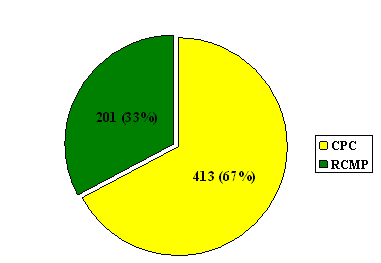
In comparing the eight detachments, it was found that:
- For the Surrey Detachment, 39 (93%) of the complaints were lodged with the Commission, while 3 (7%) of them were lodged with the RCMP.
- For the Kelowna Detachment, 22 (60%) of the complaints were lodged with the RCMP and 15 (41%) complaints were lodged with the Commission.
- For the Kamloops Detachment, 15 (52%) were lodged with the Commission and 14 (48%) were lodged with the RCMP.
- For the Prince George Detachment 17 (61%) of the complaints were lodged with the Commission and 11 (39%) were lodged with the RCMP.
- For the Coquitlam Detachment, 15 (60%) of the complaints were lodged with the Commission, while 10 (40%) of the complaints were lodged with the RCMP.
- For the North Vancouver Detachment, 15 (60%) of the complaints were lodged with the Commission and 10 (40%) were lodged with the RCMP.
- For the Richmond Detachment, 15 (60%) of the complaints were lodged with the Commission, while 10 (40%) were lodged with the RCMP.
- For the Langley Detachment, just as many complaints were lodged with the Commission (50%) as they were with the RCMP (50%).
The average number of members named in the complaint for "E" Division was 1.5, with constables (74%) most frequently being represented in the complaints, followed by corporals (12%).
"E" Division: Number of Complaints by Member Rank
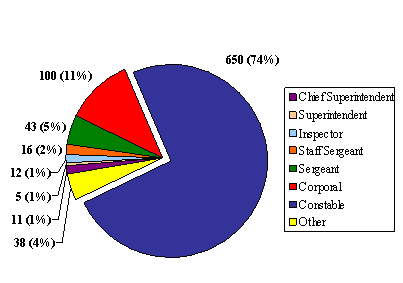
Allegations
A total of 1,335 allegations were made against members in "E" Division, which averaged about 2.2 allegations per complaint. The three most common allegations were "Neglect of Duty" (29%), "Improper Attitude" (21%) and "Improper Use of Force" (13%).
"E" Division: Allegations Breakdown
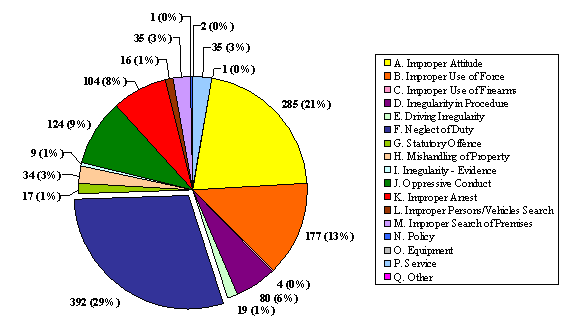
Allegations were also examined at the detachment level:
- For the Surrey Detachment, the results indicated that the most common allegation was "Neglect of Duty" (37%), followed by "Improper Attitude" (16%) and "Oppressive Conduct" (13%).
- For the Kelowna Detachment, the results indicated that the most common allegations included "Neglect of Duty" (29%), "Improper Use of Force" (21%), "Improper Attitude" (20%) and "Oppressive Conduct" (11%).
- For the Kamloops Detachment, the common allegations were "Neglect of Duty" (45%), "Oppressive Conduct" (21%) and "Improper Attitude" (19%).
- For the Prince George Detachment, the most common allegation was "Neglect of Duty" (21%), then "Improper Attitude" (20%), "Improper Use of Force" (16%), "Irregularity in Procedure" (14%) and "Oppressive Conduct" (11%).
- For the Coquitlam Detachment, typical allegations included "Neglect of Duty" (26%), "Improper Use of Force" (19%), "Improper Attitude" (17%), "Oppressive Conduct" (14%) and "Improper Arrest" (13%).
- For the North Vancouver Detachment the most common allegations were "Neglect of Duty" (32%) and "Improper Attitude" (30%).
- For the Richmond Detachment, the most common allegations were "Neglect of Duty" (30%), followed by "Improper Arrest" (16%), "Improper Search of Premises" (16%), "Improper Use of Force" (11%) and "Oppressive Conduct" (11%).
- For the Langley Detachment, the most common allegation was "Neglect of Duty" (46%), then "Oppressive Conduct" (20%), "Improper Attitude" (11%) and "Improper Arrest" (11%).
Allegations were further analyzed by member rank. In "E" Division, "Neglect of Duty" (27%) was the most common allegation made against constables, followed by "Improper Attitude" (22%) and "Improper Use of Force" (15%).
Corporals were typically subject to allegations of "Neglect of Duty" (31%), "Improper Attitude" (22%), "Oppressive Conduct" (12%) and "Improper Use of Force" (11%).
Surprisingly, "Improper Use of Force" (37%) was the most common allegation made against chief superintendents, but further analysis would have to be conducted to determine why that is.
For every complaint disposition received, the Commission analyzed the reason and incident details in order to identify issues related to the nature of the complaint. By cross-referencing these issues with the RCMP allegations, the Commission was able to identify key issues that come up for each allegation. The most common issues that were raised in the complaints for "E" Division were "Attitude" (18%), "Arrest" (10%), "Criminal Investigation Quality (RCMP)" (9%) and "Vehicular Incidents" (9%).
| Issue | Number of Complaints | % |
|---|---|---|
| Aboriginal community | 6 | 0.4% |
| Abusive Language | 35 | 2.2% |
| Alcohol or Drugs (not impairment) | 40 | 2.5% |
| Arrest | 166 | 10.2% |
| Attitude | 286 | 17.6% |
| Care in Custody | 22 | 1.4% |
| Chemical Irritant | 13 | 0.8% |
| Child Abuse Response | 5 | 0.3% |
| Child Custody | 9 | 0.6% |
| Civil Disputes/No Child | 17 | 1.0% |
| Conflict of Interest | 8 | 0.5% |
| Criminal Investigation Quality (RCMP) | 145 | 8.9% |
| Crowd Control | 1 | 0.1% |
| Custody Deaths | 8 | 0.5% |
| Detention | 48 | 3.0% |
| Entry of Premises | 28 | 1.7% |
| Impairment | 51 | 3.1% |
| Informants/Sources | 1 | 0.1% |
| Lethal Weapons | 9 | 0.6% |
| Lying under Oath | 3 | 0.2% |
| Medical Care | 27 | 1.7% |
| Mental Illness | 32 | 2.0% |
| Non-custody Deaths | 1 | 0.1% |
| Non-lethal weapons other than chemical irritants | 30 | 1.9% |
| Non-pursuit Police Driving | 4 | 0.2% |
| Non-spousal, Non-child Assault Response | 25 | 1.5% |
| Non-spousal, Non-child Sexual Assault Response | 4 | 0.2% |
| Note-taking Quality | 4 | 0.2% |
| Other (if necessary) | 33 | 2.0% |
| Police Dogs | 6 | 0.4% |
| Police Physical Abuse | 71 | 4.4% |
| Police Pursuit Driving | 5 | 0.3% |
| Policy | 13 | 0.8% |
| Property Mishandling | 32 | 2.0% |
| Public Complaint Process Quality (RCMP) | 33 | 2.0% |
| Release/Disclosure of Information | 18 | 1.1% |
| Restraints | 33 | 2.0% |
| Right to Counsel | 17 | 1.0% |
| Search | 53 | 3.3% |
| Seizure | 35 | 2.2% |
| Service | 62 | 3.8% |
| Spousal Abuse Response | 28 | 1.7% |
| Vehicular Incidents | 142 | 8.8% |
| Youth Interaction | 12 | 0.7% |
| Total | 1,621 |
Trends in the issues were also identified by detachment:
- The main issue identified in complaints from the Surrey Detachment was "Attitude" (20%), followed by "Criminal Investigation Quality" (13%) and "Arrest" (9%).
- The main issue identified in complaints from the Kelowna Detachment was "Attitude" (13%), followed by "Arrest" (12%) and "Vehicular Incidents" (10%).
- The main issues in complaints from the Kamloops Detachment were "Attitude" (26%), "Criminal Investigation Quality (RCMP)" (15%) and "Vehicular Incidents" (11%).
- The main issue for the Prince George Detachment was also "Attitude" (16%), followed by "Criminal Investigation Quality (RCMP)" (10%) and "Arrest" (8%).
- The main issues identified for the Coquitlam Detachment were "Attitude" (12%), "Arrest" (11%) and "Vehicular Incidents" (11%).
- The main issues identified in complaints for the North Vancouver Detachment were "Attitude" (23%) and "Arrest" (15%).
- The key issue for the Richmond Detachment was "Attitude" (14%), then "Arrest" (12%) and "Vehicular Incidents" (12%).
- The main issue for the Langley Detachment was "Attitude" (12%), then "Criminal Investigation Quality (RCMP)" (11%).
Further, the results revealed trends in the issues for each allegation. For the purpose of this analysis, the common issues will be reported for the three most frequently occurring allegations: "Neglect of Duty", "Improper Attitude" and "Improper Use of Force".
For complaints alleging "Neglect of Duty" the key issues were "Criminal Investigation Quality (RCMP)" (17%), "Attitude" (11%) and "Service" (9%).
The main issues identified in complaints alleging "Improper Attitude" included "Attitude" (31%), "Vehicular Incidents" (11%) and "Arrest" (7%). Finally, for allegations involving "Improper Use of Force" the key issues identified were "Arrest" (19%), "Police Physical Abuse" (13%) and "Attitude" (10%).
Disposition of Complaints
"E" Division: Number of Complaints by Disposition Type
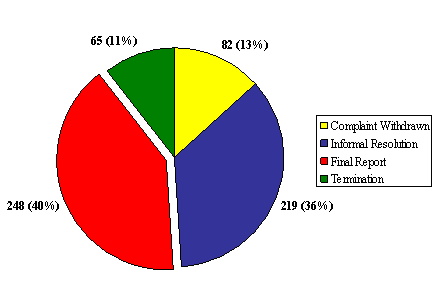
Investigation and Final Report
Of the complaint dispositions the Commission received from "E" Division, 248 (40%) were formally investigated and a Final Report by the RCMP was issued. These reports made determinations on 405 allegations with allegations of "Neglect of Duty" and "Improper Use of Force" being the most common.
At the detachment level, Final Reports accounted for:
- 7 of the 42 dispositions received from the Surrey Detachments (17%);
- 26 of the 37 dispositions received from the Kelowna Detachment (70%);
- 8 of the 29 dispositions received from the Kamloops Detachment (28%);
- 12 of the 28 dispositions received from the Prince George Detachment (43%);
- 18 of the 25 dispositions received from the Coquitlam Detachment (72%);
- 5 of the 25 dispositions received from the North Vancouver Detachment (20%);
- 14 of the 25 dispositions received from the Richmond Detachment (56%); and
- 16 of the 24 dispositions received from the Langley Detachment (67%).
Most of the RCMP's findings contained in the Final Report did not support the complainant's allegation(s). For almost every type of allegation, with the exception of "Improper Use of Firearms", the overwhelming majority (77-100%) of the RCMP's findings did not support the complainant's allegation(s). For allegations involving "Improper Use of Firearms", half of the findings supported the complainant's allegation(s), while the other half did not.
Informal Resolutions
Accounting for the second most common way to dispose of a complaint, informal resolutions occurred in 36% of the cases. In total, 369 allegations were informally resolved, the most common being "Improper Attitude".
At the detachment level, informal resolutions accounted for:
- 11 (26%) of the complaints from the Surrey Detachment;
- 8 (22%) of the complaints from the Kelowna Detachment;
- 10 (34%) of the complaints from the Kamloops Detachment;
- 13 (46%) of the complaints from the Prince George Detachment;
- 3 (12%) of the complaints from the Coquitlam Detachment;
- 18 (72%) of the complaints from the North Vancouver Detachment;
- 5 (20%) of the complaints from the Richmond Detachment; and
- 5 (21%) of the complaints from the Langley Detachment.
Withdrawals
In 13% of the cases, the complainant withdrew the complaint. In total, 177 allegations were withdrawn, the most common being "Neglect of Duty".
At the detachment level, withdrawals accounted for:
- 7 (17%) complaint dispositions from the Surrey Detachment;
- 1 (3%) complaint disposition from the Kelowna Detachment;
- 7 (24%) complaint dispositions from the Kamloops Detachment;
- 3 (11%) complaint dispositions from the Prince George Detachment;
- 3 (12%) complaint dispositions from the Coquitlam Detachment;
- 2 (8%) complaint dispositions from the North Vancouver Detachment;
- 3 (12%) complaint dispositions from the Richmond Detachment; and
- 1 (4%) complaint disposition from the Langley Detachment.
Terminations (Notice of Direction)50
In 2007, in 11% of all public complaints received from "E" Division, a Notice of Direction (termination) was issued. In 2% of the 65 cases, the termination paragraph was not specified in the Notice of Direction. In total, 120 allegations were subject to termination paragraphs, with allegations of "Neglect of Duty" being most common. Termination paragraph (c) was most often invoked.
At the detachment level, Notice of Directions accounted for:
- 17 (40%) complaint dispositions received from the Surrey Detachment;
- 2 (5%) complaint dispositions from the Kelowna Detachment;
- 4 (14%) complaint dispositions received from the Kamloops Detachment;
- 1 (4%) complaint disposition received from the Coquitlam Detachment;
- 3 (12%) complaint dispositions received from the Richmond Detachment; and
- 2 (8%) complaint dispositions received from the Langley detachment.
"E" Division: Number of Terminated Complaints by Grounds Identified in subsection 45.36(5) of the RCMP Act
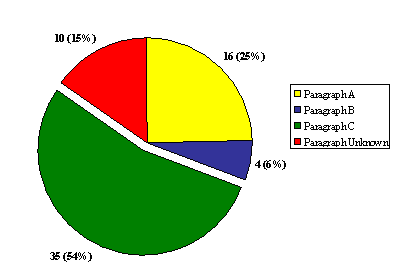
Service Standards: Complaint Processing Time
In 2007, "E" Division, on average, took 111 days to issue a disposition once a complaint was lodged (range: 0 to 447 days). This is in comparison to the RCMP national average of 114 days to issue a disposition once a complaint was lodged (range: 0 to 447 days). It typically took complainants 180 days after the incident date to file a complaint (range: 0 to 5,326 days).
"E" Division: Complaint Timeline by Organization it Was Lodged With
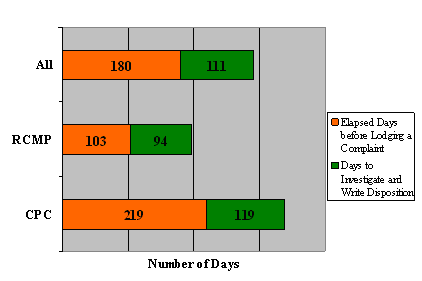
The average number of days to issue a disposition was 119 for Commission-lodged complaints (range: 0 to 447 days) as opposed to 94 days for RCMP-lodged complaints (range: 0 to 355 days). On average, complainants waited 219 days after the incident took place before lodging a complaint with the Commission (range: 0 to 5,326 days), while complaints lodged with the RCMP averaged 103 days after the incident (range: 0 to 3,997 days).51
Independent of the public complaint processing timelines the Review of the Record Project required the RCMP to provide the Commission copies of all dispositions for its analyses. To that end, the average number of days for the Commission to receive the complaint disposition from this division was 96 for Commission-lodged complaints (range: 0 to 496 days) as opposed to the 71 days it took for RCMP-lodged complaints (range: 2 to 287 days).
Complaint processing times were analyzed for each of the eight detachments who were identified most often in the complaints.
- On average, the Surrey Detachment took 88 days to issue a disposition once a complaint was lodged (range: 3 to 331 days). Typically, for these cases complainants waited 122 days after the incident date to lodge the original complaint (range: 0 to 818 days).
- The Kelowna Detachment took an average of 105 days to issue a disposition once a complaint was lodged (range: 8 to 300 days). Complainants, on average, lodged the original complaint 194 days after the incident date (range: 0 to 2,717 days).
- The Kamloops Detachment, on average, took 104 days to issue a disposition following receipt of the complaint (range: 0 to 283 days). For these cases complainants waited an average of 54 days after the incident to lodge the complaint (range: 0 to 255 days).
- In general, the Prince George Detachment took 104 days to issue a disposition (range: 0 to 358 days). Complainants waited an average of 139 days following the incident date to file the original complaint (range: 1 to 2,468 days).
- The Coquitlam Detachment took 111 days to issue a disposition (range: 9 to 258 days). Complainants waited an average of 212 days following the incident date to file the original complaint (range: 0 to 3,413 days).
- The North Vancouver Detachment took 74 days to issue a disposition (range: 5 to 356 days). Complainants waited an average of 90 days following the incident date to file the original complaint (range: 0 to 1,007 days).
- The Richmond Detachment, on average, took 65 days to issue a disposition (range: 4 to 173 days). Complainants waited an average of 237 days following the incident date to file the original complaint (range: 0 to 2,117 days).
- The Langley Detachment took 111 days to issue a disposition (range: 22 to 259 days). Complainants waited an average of 309 days following the incident date to file a complaint (range: 0 to 2,499 days).
Complaint timelines were also determined by disposition type.
- To issue a Final Report by the RCMP it took, on average, 155 days (range: 5 to 447 days). In these cases, it generally took 230 days to elapse before a complainant lodged the original complaint that resulted in this type of disposition (range: 0 to 5,326 days).
- To capture a withdrawal it took an average of 95 days (range from 0 to 297 days). It generally took 143 days to elapse before a complainant lodged the original complaint that resulted in this type of disposition (range: 0 to 1,940 days).
- To issue a Notice of Direction invoking any of the termination provisions it took, on average, 87 days (range: 4 to 345 days). It generally took 333 days to elapse before a complainant lodged a complaint that resulted in this type of disposition (range: 0 to 3,997 days).
- To enter into an informal resolution it took 74 days (range from 0 to 397 days). In these cases, it generally took 95 days to elapse before a complainant lodged the original complaint that resulted in this type of disposition (range: 0 to 2,233 days).
"E" Division: Number of Days to Issue the Disposition by Disposition Type
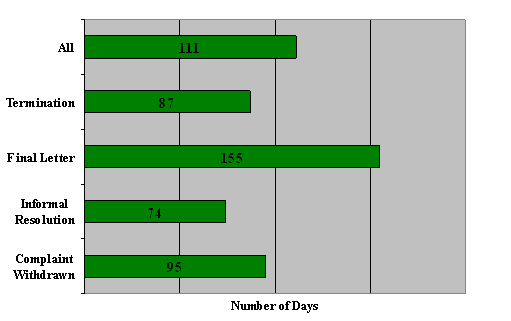
Complaint timelines were also determined by allegation type. For the three most common types of allegations, i.e. "Neglect of Duty", "Improper Attitude" and "Improper Use of Force", timelines are reported.
- For complaints involving allegations of "Neglect of Duty", on average, "E" Division RCMP took 115 days to issue a disposition (range: 0 to 397 days). Typically, complainants waited 259 days after the incident date to lodge a complaint (range: 0 to 3,413 days) for this type of allegation.
- For "Improper Attitude", on average, "E" Division RCMP took 105 days to issue a disposition (range: 0 to 355 days). Complainants, on average, lodged the original complaint 91 days after the incident date (range: 0 to 5,326 days) for this type of allegation.
- Finally, for "Improper Use of Force" "E" Division RCMP typically took 133 days to issue a disposition once a complaint was lodged (range: 0 to 358 days). On average, complainants waited 95 days to lodge a complaint (range: 0 to 2,499 days) for this type of allegation.
It is interesting to note that within "E" Division complaints involving "Improper Use of Firearms" allegations, on average, took the longest time (235 days) to issue dispositions. All of the complaints alleging this activity were formally investigated and a Final Report was issued by the RCMP in this division.
F-Saskatchewan
Complaints Received
The Commission received 137 complaint dispositions of which 48% were lodged with the Commission, 48% were lodged with the RCMP and 4% were lodged with the FSIN.
"F" Division: Number of Complaints Based on the Organization it Was Lodged With
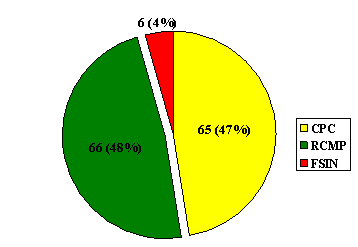
Of the 137 complaints received from "F" Division, 66 (48%) were lodged with the RCMP, 65 (48%) were lodged with the Commission and 6 (4%) were lodged with the FSIN. In comparing the five detachments, it was found that:
- For the North Battleford Detachment, 5 (50%) of the complaints were lodged with the Commission, 4 (40%) of them were lodged with the RCMP and 1 (10%) was lodged with the FSIN.
- For the La Loche Detachment, 7 (78%) of the complaints were lodged with the CPC, 2 (22%) were lodged with the FSIN and none (0%) were lodged with the RCMP.
The average number of members named in the complaints for "F" Division was 1.4, with the rank of constable being represented most often (79%) followed by the rank of corporal (11%) and sergeant (5%).
"F" Division: Number of Complaints by Member Rank
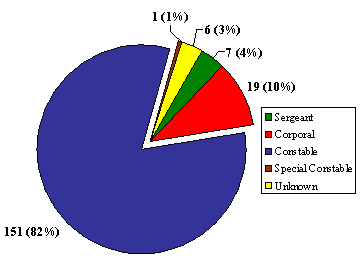
Allegations
A total of 268 allegations were made against members in "F" Division, which averaged about 2 allegations per complaint. The three most common allegations were "Improper Use of Force" (25%), "Improper Attitude" (24%) and "Neglect of Duty" (22%).
"F" Division: Allegations Breakdown
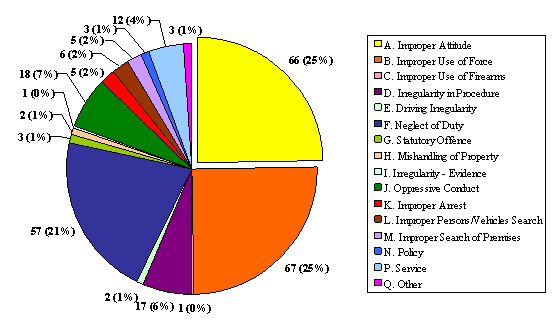
Allegations could also be examined at the detachment level:
- For the North Battleford Detachment, the results indicated that the common allegations were "Improper Attitude" (37%), followed by "Improper Use of Force" (16%), "Neglect of Duty" (16%) and "Service" (16%).
- For the La Loche Detachment, the results indicated that the common allegations were "Improper Use of Force" (73%) and "Improper Attitude" (13%).
"F" Division: Allegations for FSIN-Lodged Complaints
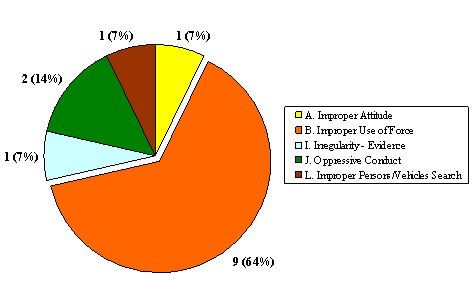
Allegations were further analyzed by member rank. In "F" Division RCMP, "Improper Attitude" (27%), "Improper Use of Force" (25%) and "Neglect of Duty" (22%) were the most common allegations against constables. Similarly, corporals were typically subject to complaints alleging "Neglect of Duty" (15%) and "Improper Use of Force" (42%). Sergeants were most likely to be subject to allegations of "Improper Attitude" (40%).
For every complaint disposition received, the Commission analyzed the reason and incident details in order to identify issues related to the nature of the complaint. By cross-referencing these issues with the RCMP allegations, the Commission was able to identify key issues that come up for each allegation. The most common issues that were raised in the complaints for "F" Division were "Attitude" (18%), "Arrest" (12%), "Criminal Investigation Quality (RCMP)" (9%) and "Vehicular Incidents" (6%).
| Issue | Number of Complaints | % |
|---|---|---|
| Aboriginal community | 7 | 2.2% |
| Abusive Language | 6 | 1.9% |
| Alcohol or Drugs (not impairment) | 6 | 1.9% |
| Arrest | 39 | 12.0% |
| Attitude | 58 | 17.9% |
| Care in Custody | 7 | 2.2% |
| Chemical Irritant | 2 | 0.6% |
| Child Custody | 2 | 0.6% |
| Civil Disputes/No Child | 4 | 1.2% |
| Criminal Investigation Quality (RCMP) | 30 | 9.3% |
| Detention | 13 | 4.0% |
| Entry of Premises | 7 | 2.2% |
| Impairment | 8 | 2.5% |
| Lethal Weapons | 2 | 0.6% |
| Medical Care | 8 | 2.5% |
| Mental Illness | 2 | 0.6% |
| Non-lethal weapons other than chemical irritants | 10 | 3.1% |
| Non-pursuit Police Driving | 1 | 0.3% |
| Non-spousal, Non-child Assault Response | 2 | 0.6% |
| Other (if necessary) | 8 | 2.5% |
| Police Physical Abuse | 16 | 4.9% |
| Police Pursuit Driving | 2 | 0.6% |
| Policy | 1 | 0.3% |
| Property Mishandling | 4 | 1.2% |
| Public Complaint Process Quality (RCMP) | 9 | 2.8% |
| Release/Disclosure of Information | 4 | 1.2% |
| Restraints | 9 | 2.8% |
| Right to Counsel | 6 | 1.9% |
| Search | 10 | 3.1% |
| Seizure | 2 | 0.6% |
| Service | 9 | 2.8% |
| Spousal Abuse Response | 5 | 1.5% |
| Vehicular Incidents | 20 | 6.2% |
| Youth Interaction | 5 | 1.5% |
| Total | 324 |
Disposition of Complaints
"F" Division: Number of Complaints by Disposition Type
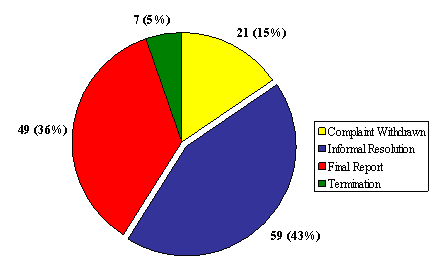
Investigation and Final Report
Of the complaint dispositions the Commission received from "F" Division, 49 (36%) were formally investigated and a Final Report by the RCMP issued. These reports made determinations on 124 allegations, with the most common allegation being "Improper Use of Force".
For almost every type of allegation, with the exception of "Mishandling of Property", the majority (57-100%) of the RCMP's findings did not support the complainant's allegation(s). For the allegation relating to "Mishandling of Property", the RCMP supported the complainant's allegations.
Informal Resolutions
Accounting for the most common way in this division to dispose of a complaint, informal resolutions occurred in close to half (44%) of the cases. Informal resolution disposed of 94 allegations. The percentage of dispositions that resulted in informal resolutions in "F" Division was 14 percentage points higher than the Force-wide percentage of 30.
The majority of complaints involving allegations of "Improper Attitude" resulted in an informal resolution. Lastly, complaints involving allegations of "Neglect of Duty" were also typically informally resolved.
Withdrawals
In 15% of the cases, the complainant withdrew the complaint. This disposition type disposed of 34 allegations, the most common of which was "Neglect of Duty".
Terminations (Notice of Direction)52
In 5% of all public complaints received from "F" Division a Notice of Direction was issued. In 29% of the 7 complaints that were terminated, the termination paragraph was not specified in the Notice of Direction.
"F" Division: Number of Terminated Complaints by Grounds Identified in subsection 45.36(5) of the RCMP Act
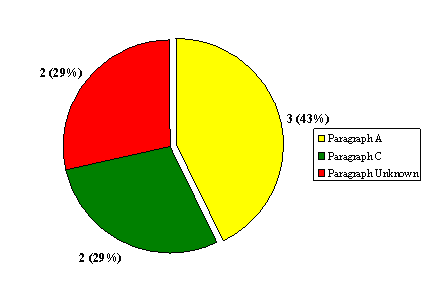
Notice of Directions disposed of 14 allegations, the most common of which was "Improper Use of Force".
Service Standards: Complaint Processing Time
In 2007, "F" Division, on average, took 137 days to issue a disposition once a complaint was lodged (range: 0 to 405 days). This is in comparison to the RCMP national average of 114 days to issue a disposition once a complaint was lodged (range: 0 to 447 days). It typically took complainants 115 days after the incident date to lodge a complaint (range: 0 to 4,062 days).
"F" Division: Complaint Timeline by Organization it Was Lodged With
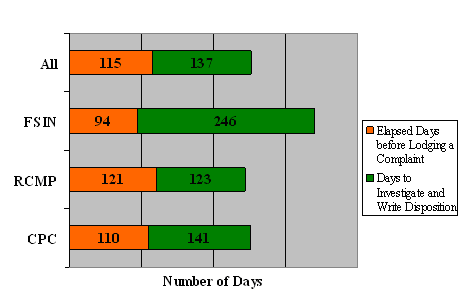
The average number of days to issue a disposition was 141 for Commission-lodged complaints (range: 0 to 405 days) as opposed to 123 days for RCMP-lodged complaints (range: 0 to 362 days). On average, complainants waited 110 days after the incident took place before lodging a complaint with the Commission (range: 0 to 1,216 days), while complaints lodged with the RCMP averaged 121 days after the incident (range: 0 to 4,062 days).53
Independent of the public complaint processing timelines, the Review of the Record Project required the RCMP to provide the Commission copies of all dispositions for its analyses. To that end, the average number of days for the Commission to receive the complaint disposition from this division was 74 for Commission-lodged complaints (range: 13 to 217 days) as opposed to the 57 days it took for RCMP-lodged complaints (range: 9 to 224 days).
For complaints lodged with the FSIN, it took an average of 246 days to issue a disposition once a complaint was lodged (range: 47 to 364 days) and another 52 days for the Commission to receive a copy of the disposition (range: 18 to 95 days). Complainants, on average, lodged a complaint 94 days after the incident date (range: 34 to 215 days).
Complaint processing times were analyzed for each of the 2 detachments identified most often in complaint dispositions:
- The North Battleford Detachment took 158 days to issue a disposition once a complaint was lodged (range: 0 to 364 days). Typically, for these cases complainants waited 137 days after the incident date to lodge the original complaint (range: 1 to 934 days).
- The La Loche Detachment took an average of 165 days to issue a disposition once a complaint was lodged (range: 47 to 280 days). Complainants, on average, lodged the original complaint 43 days after the incident date (range: 0 to 215 days).
Complaint timelines were also determined by disposition type:
- To issue a Final Report by the RCMP it took 212 days (range: 83 to 364 days). For these cases, it generally took 82 days to elapse before a complainant lodged the original complaint that resulted in this type of disposition (range: 0 to 557 days).
- To enter into an informal resolution it took 89 days (range: 0 to 405 days). For these cases, it generally took 146 days to elapse before a complainant lodged the original complaint that resulted in this type of disposition (range: 0 to 4,062 days).
- For a complainant to withdraw a complaint it took 75 days (range: 0 to 268 days). For these cases, it generally took 133 days to elapse before a complainant lodged a complaint that resulted in this type of disposition (range: 1 to 865 days).
- To issue a Notice of Direction invoking any termination provision it took 204 days (range: 24 to 315 days). For these cases, it generally took 24 days to elapse before a complainant lodged the original complaint that resulted in this type of disposition (range: 1 to 68 days).
"F" Division: Number of Days to Issue the Disposition by Disposition Type
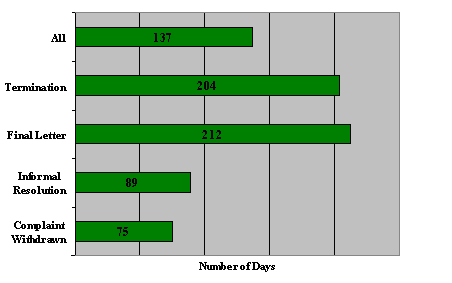
Complaint timelines were also determined by allegation type. For the three most common types of allegations, i.e. "Improper Use of Force" "Improper Attitude" and "Neglect of Duty", timelines are reported.
- Allegations of "Improper Use of Force", on average, took 216 days for a disposition to be issued (range: 1 to 364 days). Typically, complainants waited 46 days after the incident date to lodge the original complaint (range: 0 to 430 days) for this type of allegation.
- Allegations of "Improper Attitude", on average, took 93 days for a disposition to be issued (range: 0 to 343 days). Complainants, on average, lodged the original complaint 79 days after the incident date (range: 0 to 934 days) for this type of allegation.
- Allegations of "Neglect of Duty" took 140 days for a disposition to be issued once a complaint was lodged (range: 0 to 350 days). On average, complainants waited 148 days to lodge the original complaint (range: 0 to 1,216 days) for this type of allegation.
It is interesting to note that within "F" Division complaints involving "Policy" allegations, on average, took the longest time (159 days) to issue dispositions.
G-Northwest Territories
Complaints Received
The Commission received 12 complaint dispositions from "G" Division with complaints involving the Yellowknife Detachment accounting for 50% of the total complaint dispositions. Of the 12 complaints received from "G" Division, 10 (83%) were lodged with the Commission, while 2 (17%) were lodged with the RCMP. For the Yellowknife Detachment, 4 (67%) of the complaints were lodged with the Commission and 2 (33%) were lodged with the RCMP.
"G" Division: Number of Complaints Based on the Organization it Was Lodged With
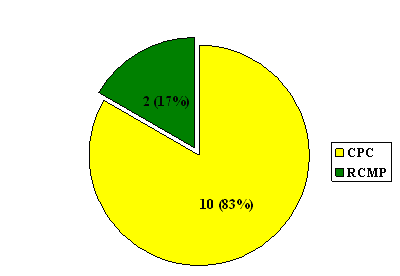
The average number of members named in the complaints for "G" Division was 1.2 with constable being represented most often in the complaints (64%), followed by the rank of corporal (21%). Other ranks were not identified.
"G" Division: Number of Complaints by Member Rank
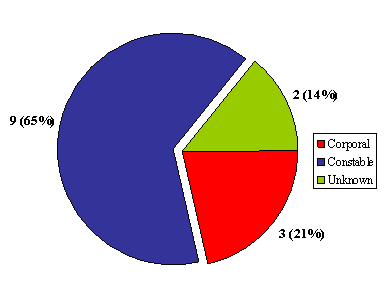
Allegations
A total of 27 allegations were made against members in "G" Division, which averaged about 2.3 allegations per complaint. The two most common allegations were "Improper Use of Force" (33%) and "Improper Attitude" (19%). For the Yellowknife Detachment, the data indicates that most of the allegations (20%) related to "Irregularity in Procedure" in that members allegedly improperly obtained personal information.
"G" Division: Allegations Breakdown
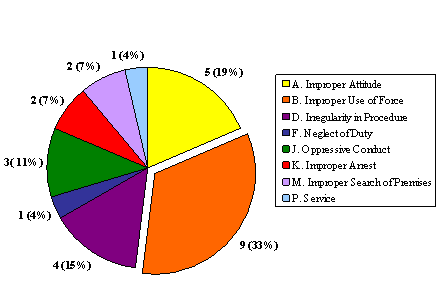
Allegations were further analyzed by member rank. For "G" Division, of the allegations made against constables, the most common allegations related to "Improper Attitude" (31%) and "Improper Use of Force" (31%). The majority of allegations against corporals related to "Improper Use of Force" (67%).
For every complaint disposition received, the Commission analyzed the reason and incident details in order to identify issues related to the nature of the complaint. By cross-referencing these issues with the RCMP allegations, the Commission was able to identify key issues that come up for each allegation. The most common issues that were raised in the complaints were "Arrest" (13%), "Attitude" (11%), "Police Physical Abuse" (11%), "Criminal Investigation Quality (RCMP)" (6%), "Entry of Premises" (6%) and "Non-lethal Weapons Other than Chemical Irritants" (6%).
| Issue | Number of Complaints | % |
|---|---|---|
| Abusive Language | 1 | 2.1% |
| Alcohol or Drugs (not impairment) | 1 | 2.1% |
| Arrest | 6 | 12.8% |
| Attitude | 5 | 10.6% |
| Care in Custody | 1 | 2.1% |
| Chemical Irritant | 1 | 2.1% |
| Civil Disputes/No Child | 1 | 2.1% |
| Criminal Investigation Quality (RCMP) | 3 | 6.4% |
| Detention | 1 | 2.1% |
| Entry of Premises | 3 | 6.4% |
| Impairment | 2 | 4.3% |
| Medical Care | 1 | 2.1% |
| Mental Illness | 2 | 4.3% |
| Non-lethal weapons other than chemical irritants | 3 | 6.4% |
| Non-spousal, Non-child Assault Response | 2 | 4.3% |
| Non-spousal, Non-child Sexual Assault Response | 1 | 2.1% |
| Police Physical Abuse | 5 | 10.6% |
| Policy | 1 | 2.1% |
| Public Complaint Process Quality (RCMP) | 1 | 2.1% |
| Restraints | 1 | 2.1% |
| Right to Counsel | 1 | 2.1% |
| Service | 1 | 2.1% |
| Spousal Abuse Response | 1 | 2.1% |
| Vehicular Incidents | 1 | 2.1% |
| Youth Interaction | 1 | 2.1% |
| Total | 47 |
Further, the results revealed trends in the issues for each allegation. For the purpose of this analysis, the common issues will be reported for the most frequently occurring allegations: "Improper Attitude" and "Improper Use of Force".
- The main issues that arose for "Improper Attitude" included "Attitude" (23%) and "Non-spousal, Non-child Assault Response" (14%).
- For allegations involving "Improper Use of Force" the key issues identified were "Arrest" (20%), "Police Physical Abuse" (17%), "Entry of Premises" (11%) and "Non-lethal Weapons Other than Chemical Irritants" (11%).
In comparing the issues raised for these two types of allegations, it appears that most of the allegations arise from situations where members are called to investigate an assault or when entering dwellings to make arrests.
Disposition of Complaints
"G" Division: Number of Complaints by Disposition Type
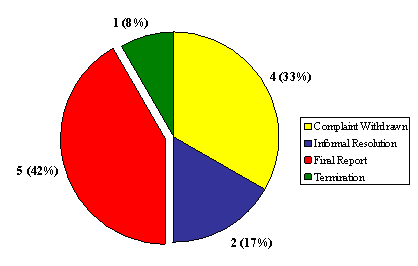
Investigation and Final Report
Of the complaint dispositions the Commission received, 5 (42%) were formally investigated and a Final Report by the RCMP was issued. These reports made determinations on 12 allegations. At the detachment level, of the total dispositions for the Yellowknife Detachment, the Commission received 4 Final Reports, which represented 12 allegations. For every type of allegation addressed in the Final Reports by the RCMP, the RCMP did not support the complainant's allegation(s).
Complaints involving allegations of "Improper Use of Force" were most often formally investigated and a Final Report was issued by the RCMP in 56% of the cases.
Informal Resolutions
Informal resolutions occurred in 17% of the cases, which dealt with 2 allegations. Allegations that were subject to an informal resolution were "Improper Use of Force" and "Irregularity in Procedure".
Withdrawals
In 33% of all the public complaints from this division, the complainant withdrew the complaint. A total of 7 llegations were disposed of in this manner. In 36% of the complaint dispositions received from the Yellowknife Detachment, the complainant withdrew the complaint.
Allegations of "Improper Attitude" were most likely to result in a withdrawal.
Terminations (Notice of Direction)54
In 2007, of all public complaints received from "G" Division, only 1 Notice of Direction under termination paragraph (b) provision was cited, which represented 2 allegations of "Improper Attitude".
Service Standards: Complaint Processing Time
On average, it took 106 days to issue a disposition once a complaint was lodged (range: 6 to 241 days). This is in comparison to the RCMP national average of 114 days to issue a disposition once a complaint was lodged (range: 0 to 447 days). It typically took close to one year (339 days) for a complainant to lodge a complaint (range: 1 to 2,166 days).
"G" Division: Complaint Timeline by Organization it Was Lodged With
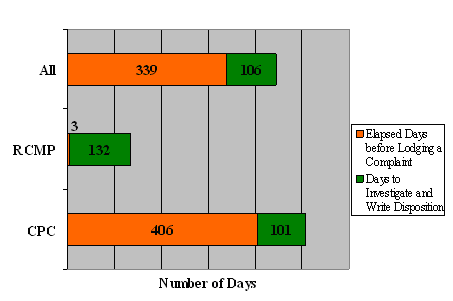
The average number of days to issue a disposition was 101 for Commission-lodged complaints (range: 6 to 169 days) as opposed to 132 days for RCMP-lodged complaints (range: 22 to 241 days). On average, complainants waited 406 days after the incident took place before lodging a complaint with the Commission (range: 1 to 2166 days), while complaints lodged with the RCMP averaged 3 days after the incident.55
Independent of the public complaint processing timelines, the Review of the Record Project required the RCMP to provide the Commission copies of all dispositions for its analyses. To that end, the average number of days for the Commission to receive the complaint disposition from this division was 93 for Commission-lodged complaints (range: 27 to 224 days) as opposed to the 103 days it took for RCMP-lodged complaints (range: 56 to 149 days).
Complaints identifying the Yellowknife Detachment, on average, took 92 days to issue a disposition once a complaint was lodged (range: 6 to 241 days) and an additional 102 days for the Commission to receive a copy of the disposition (range: 56 to 154 days). Typically, complainants waited 559 days after the incident date to lodge a complaint (range: 1 to 2,166 days).
Complaint timelines were also determined by disposition type.
- To issue a Final Report it took 135 days (range: 73 to 241 days). For these cases, it generally took 736 days to elapse before a complainant lodged the original complaint that resulted in this type of disposition (range: 1 to 2,166 days).
- To issue a Notice of Direction invoking any termination provision it took 117 days. For these cases, it generally took 53 days to elapse before a complainant lodged the original complaint that resulted in this type of disposition.
- To enter into an informal resolution it took 79 days (range: 78 to 79 days). For these cases it generally took 80 days to elapse before a complainant lodged the original complaint that resulted in this type of disposition (range: 45 to 115 days).
- To receive a withdrawal it took 81 days (range: 6 to 169 days). For these cases, it generally took 43 days to elapse before a complainant lodged the original complaint that resulted in this type of disposition (range: 3 to 120 days).
"G" Division: Number of Days to Issue the Disposition by Disposition Type
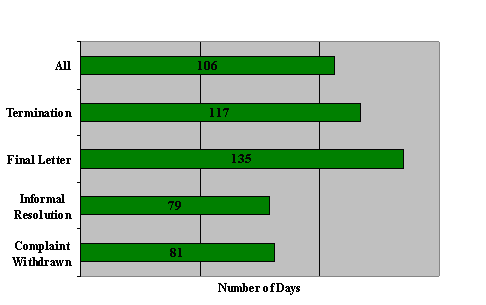
Complaint timelines were also determined by allegation type. For the most frequently occurring types of allegations, i.e. "Improper Use of Force" and "Improper Attitude", timelines are reported.
- Allegations of "Improper Use of Force", on average, took the longest time (127 days) for a disposition to be issued (range: 73 to 241 days), compared to the other types of allegations. Typically, complainants waited 486 days after the incident date to lodge the original complaint (range: 1 to 2,166 days) with this type of allegation.
- Allegations involving "Improper Attitude" took 68 days for a disposition to be issued (range: 6 to 127 days). Complainants, on average, lodged the original complaint 55 days after the incident date (range: 3 to 120 days) with this type of allegation.
H-Nova Scotia
Complaints Received
The Commission received 107 complaint dispositions of which 60 (56%) were lodged with the RCMP, while 47 (44%) were lodged with the Commission. The complaints were further examined at the detachment level. The detachments that were most often identified in the complaint dispositions included the Halifax Detachment (17%), followed by the Digby Detachment (7%) and the Eskasoni Detachment (7%).
"H" Division: Number of Complaints Based on the Organization it Was Lodged With
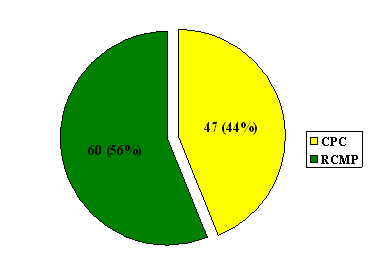
In comparing the three detachments, it was found that for the Halifax Detachment, 56% of the complaints were lodged with the RCMP, while 44% of them were lodged with the Commission, for the Digby Detachment 86% of the complaints were lodged with the RCMP and 14% were lodged with the Commission, and for the Eskasoni Detachment, no complaints were lodged with the RCMP and 100% of the complaints were lodged with the Commission.
The average number of members named in the complaint for "H" Division was 1.4, with the rank of constable (78%) being the most common rank, followed by corporal (11%) and sergeant (3%).
"H" Division: Number of Complaints by Member Rank
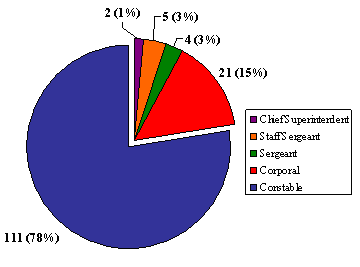
Allegations
A total of 234 allegations were made against members in "H" Division, which averaged about 2.2 allegations per complaint. The three most common allegations were "Neglect of Duty" (31%), "Improper Attitude" (17%) and "Oppressive Conduct" (17%).
"H" Division: Allegations Breakdown
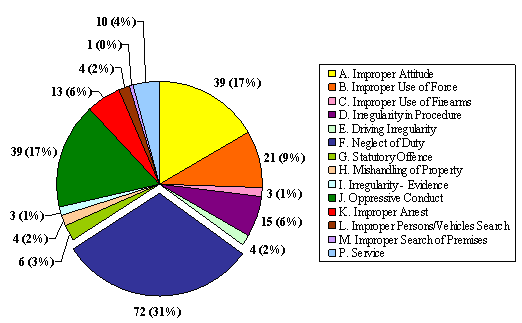
Allegations were also examined at the detachment level. For the Digby Detachment, the results indicate that half (50%) of the allegations related to "Neglect of Duty". The most common allegation for the Eskasoni Detachment was "Oppressive Conduct" (26%). Similarly, for the Halifax Detachment the most frequent allegation was "Oppressive Conduct" (33%) and equally so was "Neglect of Duty" (33%).
In "H" Division, "Neglect of Duty" was the most common allegation directed towards constables (30%), corporals (32%) and staff sergeants (60%).
For every complaint disposition received, the Commission analyzed the reason and incident details in order to identify issues related to the nature of the complaint. By cross-referencing these issues with the RCMP allegations, the Commission was able to identify key issues that come up for each allegation. The most common issues that were raised in the complaints for "H" Division were "Attitude" (20%), "Criminal Investigation Quality (RCMP)" (13%), "Arrest" (8%) and "Vehicular Incidents" (8%).
| Issue | Number of Complaints | % |
|---|---|---|
| Abusive Language | 10 | 3.7% |
| Alcohol or Drugs (not impairment) | 6 | 2.2% |
| Arrest | 20 | 7.5% |
| Attitude | 54 | 20.1% |
| Care in Custody | 3 | 1.1% |
| Chemical Irritant | 2 | 0.7% |
| Civil Disputes/No Child | 3 | 1.1% |
| Criminal Investigation Quality (RCMP) | 34 | 12.7% |
| Crowd Control | 2 | 0.7% |
| Detention | 6 | 2.2% |
| Entry of Premises | 13 | 4.9% |
| Impairment | 2 | 0.7% |
| Lethal Weapons | 1 | 0.4% |
| Medical Care | 5 | 1.9% |
| Mental Illness | 2 | 0.7% |
| Non-lethal weapons other than chemical irritants | 1 | 0.4% |
| Non-pursuit Police Driving | 1 | 0.4% |
| Non-spousal, Non-child Assault Response | 4 | 1.5% |
| Non-spousal, Non-child Sexual Assault Response | 2 | 0.7% |
| Other (if necessary) | 6 | 2.2% |
| Police Dogs | 2 | 0.7% |
| Police Physical Abuse | 8 | 3.0% |
| Police Pursuit Driving | 1 | 0.4% |
| Policy | 3 | 1.1% |
| Property Mishandling | 3 | 1.1% |
| Public Complaint Process Quality (RCMP) | 12 | 4.5% |
| Release/Disclosure of Information | 5 | 1.9% |
| Restraints | 2 | 0.7% |
| Right to Counsel | 5 | 1.9% |
| Search | 8 | 3.0% |
| Seizure | 6 | 2.2% |
| Service | 13 | 4.9% |
| Vehicular Incidents | 20 | 7.5% |
| Youth Interaction | 3 | 1.1% |
| Total | 268 |
Trends in the issues were also identified by detachment:
- For the Digby Detachment, the common issues raised were "Criminal Investigation Quality (RCMP)" (26%), followed by "Attitude" (21%) and "Property Mishandling" (11%).
- The two most common issues identified in complaints received from the Eskasoni Detachment were "Public Complaint Process Quality (RCMP)" (25%) and "Attitude" (19%).
- Lastly, for the Halifax Detachment, "Attitude" (25%) was the key issue identified in the complaints, followed by "Criminal Investigation Quality (RCMP)" (16%) and "Vehicular Incidents" (16%).
Further, the results revealed trends in the issues for each allegation. For the purpose of this analysis, the common issues will be reported for the three most frequently occurring allegations: "Neglect of Duty", "Improper Attitude" and "Oppressive Conduct".
- For complaints alleging "Neglect of Duty" the key issues were "Criminal Investigation Quality (RCMP)" (25%), "Attitude" (16%) and "Service" (10%).
- For complaints alleging "Improper Attitude" the key issues were "Attitude" (35%), "Vehicular Incidents" (11%) and "Criminal Investigation Quality (RCMP)" (9%).
- For complaints alleging "Oppressive Conduct" the key issues identified were "Attitude" (22%), "Arrest" (8%), "Release/Disclosure of Information (8%), "Entry of Premises" (6%) and "Vehicular Incidents" (6%).
In comparing the issues raised for the three most frequent allegations, it appears that there is a common perceived lack of police professionalism, as "Attitude" was the prominent issue identified in all three allegations.
Disposition of Complaints
"H" Division: Number of Complaints by Disposition Type
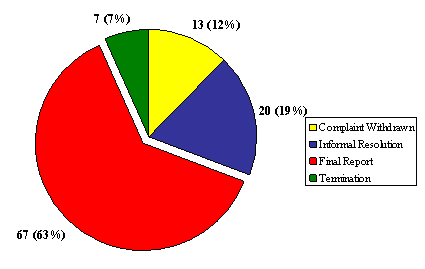
Investigation and Final Report
Of the complaint dispositions the Commission received, 67 (63%) were formally investigated and a Final Report issued by the RCMP. These reports made determinations on 167 allegations. For almost every type of allegation, with the exception of "Improper Persons/Vehicles Search", the overwhelming majority (68-100%) of the RCMP's findings did not support the complainant's allegation(s).
Allegations most likely to result in a Final Report by the RCMP were "Neglect of Duty" and "Oppressive Conduct".
Informal Resolutions
Accounting for the second most common way to dispose of a complaint, informal resolutions occurred in 19% of the cases. Informal resolutions dealt with 27 allegations, the most common of which were "Improper Attitude" and "Neglect of Duty".
Withdrawals
In 12% of the cases, the complainant withdrew the complaint. Withdrawals disposed of 31 allegations, with the most common being "Neglect of Duty".
Terminations (Notice of Direction)56
In 7% of all public complaints received a Notice of Direction was issued. In total, 9 allegations were subject to termination paragraphs. In 57% of the 7 cases, the grounds for termination were not specified in the Notice of Direction. Allegations most likely to be subject to a termination paragraph were "Neglect of Duty".
"H" Division: Number of Terminated Complaints by Grounds Identified in subsection 45.36(5) of the RCMP Act
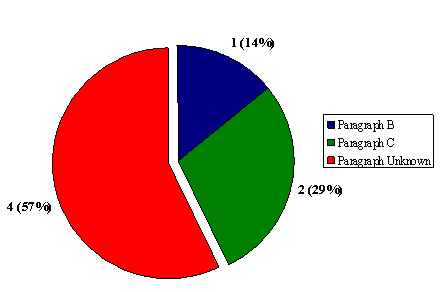
Service Standards: Complaint Processing Time
In 2007, "H" Division, on average, took 137 days to issue a disposition once a complaint was lodged (range: 5 to 401 days). This is in comparison to the RCMP national average of 114 days to issue a disposition once a complaint was lodged (range: 0 to 447 days). It typically took close to one year (309 days) for a complainant to lodge a complaint (range: 0 to 8,908 days).
"H" Division: Complaint Timeline by Organization it Was Lodged With
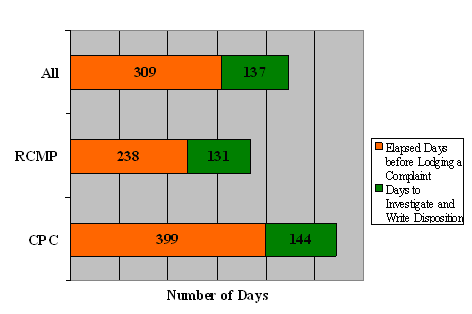
The average number of days to issue a disposition was 144 for Commission-lodged complaints (range: 16 to 400 days) as opposed to 131 days for RCMP-lodged complaints (range: 5 to 401 days). On average, complainants waited 399 days after the incident took place before lodging a complaint with the Commission (range: 0 to 3,456 days), while complaints lodged with the RCMP averaged 238 days after the incident (range: 0 to 8,908 days).57
Independent of the public complaint processing timelines, the Review of the Record Project required the RCMP to provide the Commission copies of all dispositions for its analyses. To that end, the average number of days for the Commission to receive the complaint disposition from this division was 64 for Commission-lodged complaints (range: 0 to 249 days) as opposed to the 54 days it took for RCMP-lodged complaints (range: 6 to 249 days).
Complaint processing times were analyzed for each of the three detachments that were identified most often in complaint dispositions:
- On average, the Digby Detachment took 137 days to issue a disposition once a complaint was lodged (range: 33 to 250 days). Typically, for these cases complainants waited 385 days after the incident date to lodge the original complaint (range: 0 to 2,433 days).
- The Eskasoni Detachment took an average of 146 days to issue a disposition once a complaint was lodged (range: 61 to 238 days). Complainants, on average, lodged the original complaint 99 days after the incident date (range: 0 to 281 days).
- Finally, the Halifax Detachment, on average, took 148 days to issue a disposition following receipt of the complaint (range: 7 to 324 days). Surprisingly, complainants waited an average of 902 days after the incident to lodge the original complaint (range: 5 to 8,908 days). However, this average is most likely an anomaly caused by complaints being lodged about historical issues.
Complaint timelines were also determined by disposition type:
- To issue a Final Report by the RCMP it took 166 days (range: 13 to 400 days). For these cases, it generally took 279 days to elapse before a complainant lodged the original complaint that resulted in this type of disposition (range: 0 to 3,456 days).
- To issue a notice of direction invoking any termination provision it took 78 days (range: 7 to 251 days). For these cases, it generally took 1,751 days to elapse before a complainant lodged the original complaint that resulted in this type of disposition (range: 11 to 8,908 days).
- To enter into an informal resolution it took 84 days (range: 5 to 401 days). For these cases, it generally took 54 days to elapse before a complainant lodged the original complaint that resulted in this type of disposition (range: 1 to 526 days).
- To issue a withdrawal it took 101 days (range: 15 to 288 days). For these cases, it generally took 77 days to elapse before a complainant lodged the original complaint that resulted in this type of disposition (range: 2 to 278 days).
"H" Division: Number of Days to Issue the Disposition by Disposition Type
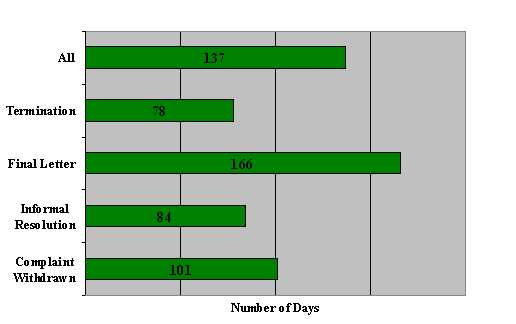
Complaint timelines were also determined by allegation type. For the three most common types of allegations, i.e. "Neglect of Duty," "Improper Attitude" and "Oppressive Conduct", timelines are reported.
- Allegations of "Neglect of Duty", on average, took 146 days for a disposition to be issued (range: 7 to 400 days). Typically, complainants waited 445 days after the incident date to lodge the original complaint (range: 0 to 8,908 days) for this type of allegation.
- Allegations of "Improper Attitude", on average, took 134 days for a disposition to be issued (range: 14 to 325 days). Complainants, on average, lodged a complaint 66 days after the incident date (range: 0 to 962 days) for this type of allegation.
- Allegations of "Oppressive Conduct" typically took 145 days for a disposition to be issued once a complaint was lodged (range: 16 to 324 days). On average, complainants waited 276 days to lodge the original complaint (range: 0 to 2,446 days) for this type of allegation.
It is interesting to note that within "H" Division complaints involving "Statutory Offence" allegations, on average, took the longest time (252 days) to issue dispositions.
J-New Brunswick
Complaints Received
The Commission received 79 complaint dispositions of which 62% were lodged with the Commission, while 38% were lodged with the RCMP. Codiac-Codiac District Detachment was identified in 28% of all public complaints related to this Division. It was found that for the Codiac-Codiac District Detachment, 64% of the complaints were lodged with the Commission and 36% were lodged with the RCMP.
"J" Division: Number of Complaints Based on the Organization it Was Lodged With
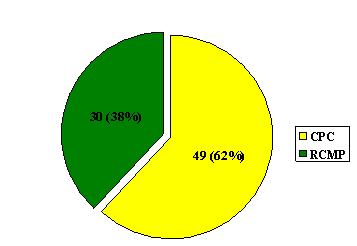
The average number of members named in the complaint for "J" Division was 1.7, with the rank of constable (69%) being the most common rank identified in the total complaints. The rank of corporal was represented in 20% of the complaints.
"J" Division: Number of Complaints by Member Rank
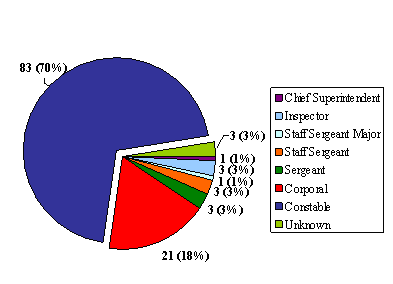
Allegations
A total of 162 allegations were made against members in "J" Division, which averaged about 2 allegations per complaint. The three most common allegations were "Neglect of Duty" (29%), "Improper Attitude" (20%) and "Improper Use of Force" (12%).
"J" Division: Allegations Breakdown
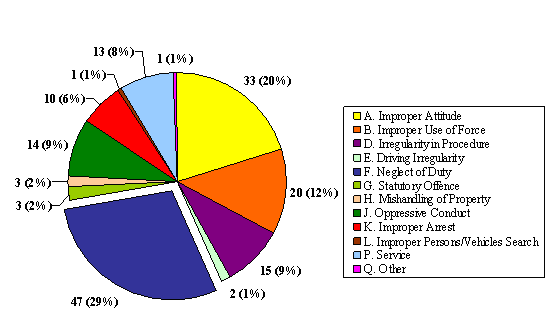
Allegations were also examined at the detachment level. For the Codiac-Codiac District Detachment, the results indicate that the most common allegations pertained to "Neglect of Duty" (29%), "Oppressive Conduct" (16%), "Improper Attitude" (13%) and "Improper Arrest" (13%).
Allegations were further analyzed by member rank. Allegations pertaining to "Neglect of Duty" (28%) were the most common allegation against constables, followed by "Improper Atttiude" (26%), and "Improper Use of Force" (17%). Corporals were typically the subject of complaints involving allegations of "Neglect of Duty" (29%) and "Oppressive Conduct" (17%).
For every complaint disposition received, the Commission analyzed the reason and incident details in order to identify issues related to the nature of the complaint. By cross-referencing these issues with the RCMP allegations, the Commission was able to identify key issues that come up for each allegation. The most common issues that were raised in the complaints for "J" Division were "Attitude" (14%), "Criminal Investigation Quality (RCMP)" (13%), "Arrest" (8%) and "Vehicular Incidents" (8%). The two most common issues identified in complaints received from the Codiac-Codiac Detachment were "Arrest" (12%), "Attitude" (12%) and "Criminal Investigation Quality" (11%).
| Issue | Number of Complaints | % |
|---|---|---|
| Abusive Language | 6 | 3.0% |
| Alcohol or Drugs (not impairment) | 5 | 2.5% |
| Arrest | 16 | 8.0% |
| Attitude | 28 | 14.0% |
| Care in Custody | 4 | 2.0% |
| Chemical Irritant | 3 | 1.5% |
| Child Abuse Response | 1 | 0.5% |
| Child Custody | 1 | 0.5% |
| Civil Disputes/No Child | 4 | 2.0% |
| Conflict of Interest | 1 | 0.5% |
| Criminal Investigation Quality (RCMP) | 22 | 11.0% |
| Detention | 9 | 4.5% |
| Entry of Premises | 3 | 1.5% |
| Impairment | 6 | 3.0% |
| Medical Care | 7 | 3.5% |
| Mental Illness | 10 | 5.0% |
| Non-lethal weapons other than chemical irritants | 1 | 0.5% |
| Non-pursuit Police Driving | 2 | 1.0% |
| Non-spousal, Non-child Assault Response | 1 | 0.5% |
| Non-spousal, Non-child Sexual Assault Response | 1 | 0.5% |
| Other (if necessary) | 6 | 3.0% |
| Police Physical Abuse | 9 | 4.5% |
| Policy | 1 | 0.5% |
| Property Mishandling | 1 | 0.5% |
| Public Complaint Process Quality (RCMP) | 8 | 4.0% |
| Release/Disclosure of Information | 5 | 2.5% |
| Restraints | 5 | 2.5% |
| Right to Counsel | 2 | 1.0% |
| Search | 6 | 3.0% |
| Seizure | 2 | 1.0% |
| Service | 6 | 3.0% |
| Spousal Abuse Response | 5 | 2.5% |
| Vehicular Incidents | 12 | 6.0% |
| Youth Interaction | 1 | 0.5% |
| Total | 200 |
Further, the results revealed trends in the issues for each allegation. For the purpose of this analysis, the common issues will be reported for the three most frequently occurring allegations: "Neglect of Duty", "Improper Attitude" and "Improper Use of Force".
- For complaints alleging "Neglect of Duty" the key issues were "Criminal Investigation Quality" (26%), "Mental Illness" (9%) and "Spousal Abuse Response" (9%).
- For complaints alleging "Improper Attitude" the key issues were "Attitude" (26%), "Detention" (10%) and "Mental Illness" (10%).
For complaints alleging "Improper Use of Force" the key issues identified were "Arrest" (18%), "Detention" (15%), "Police Physical Abuse" (10%) and "Attitude" (8%).
Disposition of Complaints
"J" Division: Number of Complaints by Disposition Type
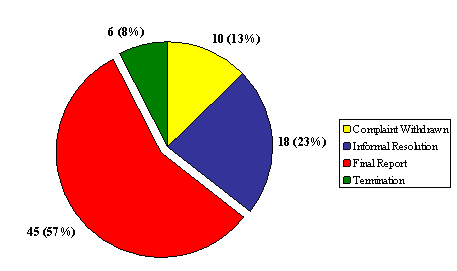
Investigation and Final Report
Of the complaint dispositions the Commission received, 57% were formally investigated and a Final Report issued by the RCMP. These reports made determinations on 112 allegations, the most common being "Neglect of Duty", "Improper Attitude" and "Improper Use of Force". For every type of allegation identified in the complaints, the overwhelming majority (67-100%) of the RCMP's findings did not support the complainant's allegation(s).
Informal Resolutions
Accounting for the second most common way to dispose of a complaint, informal resolutions occurred in 18% of the cases and dealt with 24 allegations. The most common allegation subject to an informal resolution was "Improper Attitude".
Withdrawals
In 13% of the cases, the complainant withdrew the complaint. In total, 17 allegations were informally resolved, the most common being "Improper Attitude".
Terminations (Notice of Direction)58
In 2007, 8% of all public complaints received a Notice of Direction was issued, which terminated 9 allegations. The most common allegation to be subject to any termination paragraph was "Neglect of Duty". Termination paragraph (c) was most often invoked.
"J" Division: Number of Terminated Complaints by Grounds Identified in subsection 45.36(5) of the RCMP Act
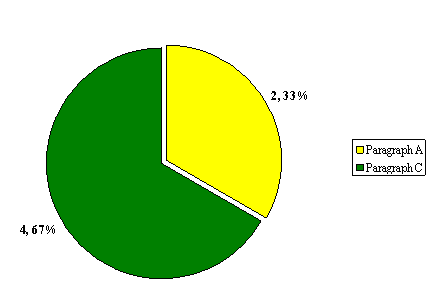
Service Standards: Complaint Processing Time
In 2007, "J" Division, on average, took 93 days to issue a disposition once a complaint was lodged (range: 0 to 336 days). This is in comparison to the RCMP national average of 114 days to issue a disposition once a complaint was lodged (range: 0 to 447 days). It typically took over a year (398 days) to elapse before a complainant lodged a complaint (range: 0 to 11,92759 days).
"J" Division: Complaint Timeline by Organization it Was Lodged With
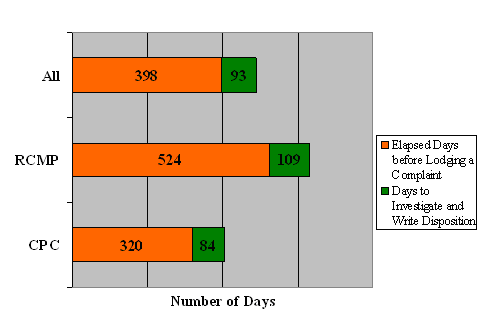
The average number of days to issue a disposition was 84 for Commission-lodged complaints (range: 16 to 268 days) as opposed to 109 days for RCMP-lodged complaints (range: 0 to 336 days). On average, complainants waited 320 days after the incident took place before lodging the original complaint with the Commission (range: 0 to 2,253 days), while complaints lodged with the RCMP averaged 524 days after the incident (range: 0 to 1,927 days).60
Independent of the public complaint processing timelines, the Review of the Record Project required the RCMP to provide the Commission copies of all dispositions for its analyses. To that end, the average number of days for the Commission to receive the complaint disposition from this division was 74 for Commission-lodged complaints (range: 7 to 270 days) as opposed to the 26 days it took for RCMP-lodged complaints (range: 5 to 93 days).
Complaint processing times were analyzed for complaints that identified Codiac-Codiac Detachment. On average, the Codiac-Codiac District Detachment took 102 days to issue a disposition once a complaint was lodged (range: 1 to 336 days). Typically, in these cases, complainants waited 390 after the incident date to lodge the original complaint (range: 0 to 2,253 days).
Complaint timelines were also determined by disposition type:
- To issue a Final Report by the RCMP it took 108 days (range: 4 to 33 days). For these cases, it generally took 553 days to elapse before a complainant lodged the original complaint that resulted in this type of disposition (range: 0 to 11,927 days).
- To issue a Notice of Direction invoking any termination provision it took 59 days (range: 16 to 208 days). For these cases, it generally took 699 days to elapse before a complainant lodged the original complaint that resulted in this type of disposition (range: 0 to 2,067 days).
- To enter into an informal resolution it took 72 days (range: 0 to 268 days). For these cases, it generally took 86 days to elapse before a complainant lodged the original complaint that resulted in this type of disposition (range: 0 to 730 days).
- To capture a withdrawal it took 87 days (range: 26 to 238 days). For these cases, it generally took 79 days to elapse before a complainant lodged the original complaint that resulted in this type of disposition (range: 0 to 328 days).
"J" Division: Number of Days to Issue the Disposition by Disposition Type
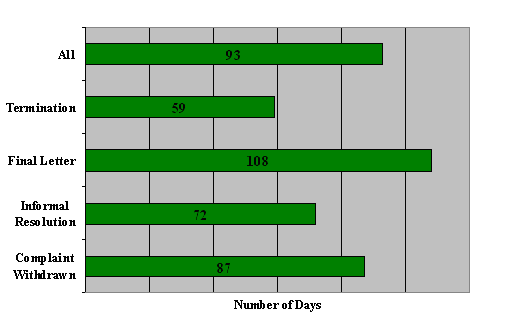
Complaint timelines were also determined by allegation type. For the three most common types of allegations, i.e. "Neglect of Duty", "Improper Attitude" and "Improper Use of Force", timelines are reported.
- Allegations of "Neglect of Duty", on average, took 94 days for a disposition to be issued (range: 8 to 336 days). Typically, complainants waited 855 days after the incident date to lodge a complaint (range from 0 to 11,927 days) for this type of allegation.
- Allegations of "Improper Attitude", on average, took 95 days for a disposition to be issued (range: 0 to 318 days). Complainants, on average, lodged a complaint 576 days after the incident date (range: 1 to 11,927 days) for this type of allegation.
- Allegations of "Improper Use of Force" typically took 136 days for a disposition to be issued once a complaint was lodged (range: 16 to 298 days). On average, complainants waited 47 days to lodge a complaint (range: 0 to 227 days) for this type of allegation.
It is interesting to note that within "J" Division complaints involving "Mishandling of Property" allegations, on average, took the longest time (209 days) to issue dispositions.
K-Alberta
Complaints Received
The Commission received 229 complaint dispositions of which 57% were lodged with the Commission, while 43% were lodged with the RCMP. Notably, the Red Deer Detachment was identified in 17% of the submitted complaint records and as a result the Commission paid particular attention to the complaint records from this detachment.
"K" Division: Number of Complaints Based on the Organization it Was Lodged With
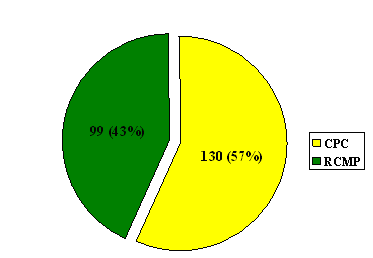
The average number of members named in the complaints for "K" Division was 1.5, with the rank of constable (75%) being the most frequently represented rank of the total complaints. The rank of corporal was represented in 8% of the complaints, while sergeants were also the subject of 8% of the complaints.
"K" Division: Number of Complaints by Member Rank
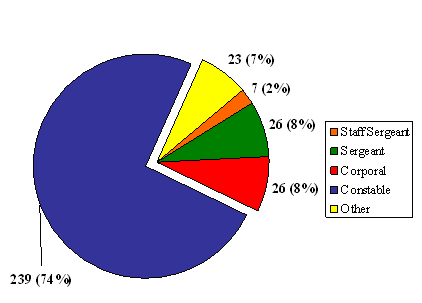
Allegations
A total of 479 allegations were made against members in "K" Division, which averaged about 2.1 allegations per complaint. The three most common allegations were "Neglect of Duty" (34%), "Improper Attitude" (19%) and "Improper Use of Force" (12%).
"K" Division: Allegations Breakdown
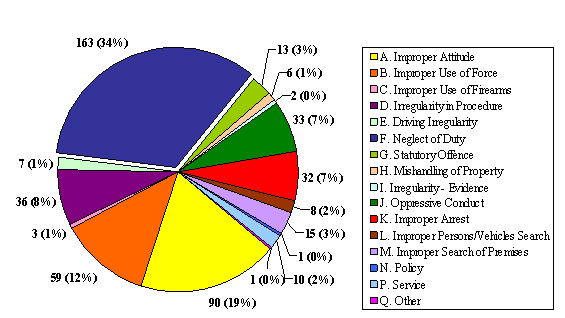
Allegations were also examined for the Red Deer Detachment. The results indicate that most (34%) of the allegations related to "Neglect of Duty", followed by "Improper Use of Force" (25%) and "Improper Attitude" (11%).
In "K" Division, the rank of constable (31%), corporal (41%), sergeant (34%), staff sergeant (57%), inspector (83%), and superintendent (100%) frequently faced allegations of "Neglect of Duty".
For every complaint disposition received, the Commission analyzed the reason and incident details in order to identify issues related to the nature of the complaint. By cross-referencing these issues with the RCMP allegations, the Commission was able to identify key issues that come up for each allegation. The common issues that were raised in the complaints for "K" Division were "Attitude" (14%), "Criminal Investigation Quality (RCMP)" (12%), "Arrest" (10%); "Service" (7%), "Vehicular Incidents" (7%) and "Police Physical Abuse" (5%).
| Issue | Number of Complaints | % |
|---|---|---|
| Aboriginal community | 3 | 0.5% |
| Abusive Language | 15 | 2.3% |
| Alcohol or Drugs (not impairment) | 13 | 2.0% |
| Arrest | 65 | 9.8% |
| Attitude | 90 | 13.6% |
| Care in Custody | 17 | 2.6% |
| Chemical Irritant | 7 | 1.1% |
| Child Abuse Response | 7 | 1.1% |
| Child Custody | 5 | 0.8% |
| Civil Disputes/No Child | 10 | 1.5% |
| Conflict of Interest | 2 | 0.3% |
| Criminal Investigation Quality (RCMP) | 78 | 11.8% |
| Crowd Control | 1 | 0.2% |
| Detention | 22 | 3.3% |
| Entry of Premises | 17 | 2.6% |
| Impairment | 20 | 3.0% |
| Informants/Sources | 1 | 0.2% |
| Lethal Weapons | 3 | 0.5% |
| Lying under Oath | 1 | 0.2% |
| Medical Care | 18 | 2.7% |
| Mental Illness | 10 | 1.5% |
| Non-lethal weapons other than chemical irritants | 2 | 0.3% |
| Non-pursuit Police Driving | 3 | 0.5% |
| Non-spousal, Non-child Assault Response | 7 | 1.1% |
| Non-spousal, Non-child Sexual Assault Response | 3 | 0.5% |
| Note-taking Quality | 1 | 0.2% |
| Other (if necessary) | 2 | 0.3% |
| Police Physical Abuse | 36 | 5.4% |
| Police Pursuit Driving | 1 | 0.2% |
| Policy | 11 | 1.7% |
| Property Mishandling | 6 | 0.9% |
| Public Complaint Process Quality (RCMP) | 5 | 0.8% |
| Release/Disclosure of Information | 7 | 1.1% |
| Restraints | 11 | 1.7% |
| Right to Counsel | 13 | 2.0% |
| Search | 23 | 3.5% |
| Seizure | 11 | 1.7% |
| Service | 48 | 7.3% |
| Spousal Abuse Response | 9 | 1.4% |
| Vehicular Incidents | 47 | 7.1% |
| Youth Interaction | 11 | 1.7% |
| Total | 662 |
Trends in the issues were also identified for the Red Deer Detachment, where the common issues raised were "Arrest" (15%), followed by "Attitude" (9%), "Criminal Investigation Quality (RCMP)" (9%) and "Police Physical Abuse" (9%).
In "K" Division, the results revealed trends in the issues for each allegation. For the purpose of this analysis, the common issues will be reported for the three most frequently occurring allegations: "Neglect of Duty", "Improper Attitude" and "Improper Use of Force".
In complaints alleging "Neglect of Duty" the key issues were "Criminal Investigation Quality (RCMP)" (22%), "Attitude" (12%) and "Service" (11%). The main issues raised in complaints alleging "Improper Attitude" included "Attitude" (26%), "Arrest" (9%) and "Criminal Investigation Quality (RCMP)" (9%). Finally, for allegations involving "Improper Use of Force" the key issues identified were "Arrest" (17%), "Police Physical Abuse" (16%) and "Attitude" (10%). In comparing the issues raised for three most frequent allegations, it appears that there is a common perceived lack of police professionalism, as "Attitude" was the prominent issue identified in all three allegations.
Disposition of Complaints
"K" Division: Number of Complaints by Disposition Type
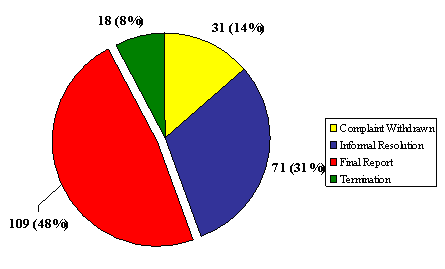
Investigation and Final Report
Of the complaint dispositions the Commission received, the majority (48%) were formally investigated and a Final Report was issued by the RCMP. These reports made determinations on 305 allegations, the most common of which were "Neglect of Duty", "Improper Attitude", "Improper Use of Force" and "Statutory Offence". For every type of allegation contained in the complaints the overwhelming majority (75-100%) of the RCMP's findings did not support the complainant's allegation(s).
Informal Resolutions
Accounting for the second most common way to dispose of a complaint, informal resolutions occurred in 31% of the cases. It is interesting to note that while 31% of "K" Division public complaints were informally resolved, 47% of the public complaints originating in the Red Deer Detachment were disposed of in this manner, which is 16 percentage points higher than the division average, and 17 percentage points higher than the Force-wide average.
Informal resolutions dealt with 105 allegations, the most common being "Neglect of Duty".
Withdrawals
In 14% of the cases, the complainant withdrew the complaint. Withdrawals dealt with 44 allegations, the most common being "Neglect of Duty". Interestingly, 20% of all the public complaints involving the Grande Prairie Detachment were withdrawn.
Terminations (Notice of Direction)61
In 2007, in 8% of all public complaints received from "K" Division, a Notice of Direction was issued. In 33% of the 18 cases, the termination paragraph was not specified in the Notice of Direction. In total, 25 allegations were subject to a termination paragraph, the most common of which was "Neglect of Duty". The grounds for termination most often invoked was paragraph (c).
"K" Division: Number of Terminated Complaints by Grounds Identified in subsection 45.36(5) of the RCMP Act
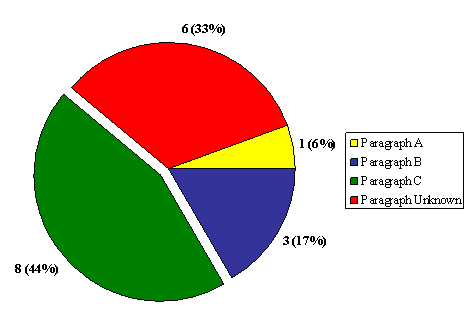
Service Standards: Complaint Processing Time
In 2007, "K" Division, on average, took 120 days to issue a disposition once a complaint was lodged (range: 0 to 396 days). This is in comparison to the RCMP national average of 114 days to issue a disposition once a complaint was lodged (range: 0 to 447 days). It typically took 197 days to elapse before a complainant lodged a complaint (range: 0 to 4,702 days).
"K" Division: Complaint Timeline by Organization it Was Lodged With
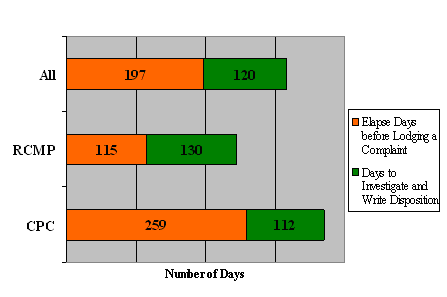
The average number of days to issue a disposition was 112 for Commission-lodged complaints (range: 0 to 352 days) as opposed to 130 days for RCMP-lodged complaints (range: 0 to 396 days). On average, complainants waited 259 days after the incident took place before lodging a complaint with the Commission (range: 0 to 4,702 days), while complaints lodged with the RCMP averaged 115 days after the incident (range: 0 to 2,402 days).62
Independent of the public complaint processing timelines, the Review of the Record Project required the RCMP to provide the Commission copies of all dispositions for its analyses. To that end, the average number of days for the Commission to receive the complaint disposition from this division was 110 for Commission-lodged complaints (range: 11 to 331 days) as opposed to the 90 days it took for RCMP-lodged complaints (range: 3 to 349 days).
Specific to the Red Deer Detachment it took 110 days to issue a disposition once a complaint was lodged (range: 0 to 251 days). Typically, complainants waited 126 days after the incident date to lodge the original complaint (range: 0 to 591 days).
Complaint timelines were also determined by disposition type:
- To issue a Final Report by the RCMP it took 175 days (range: 22 to 396 days). For these cases it generally took 176 days to elapse before a complainant lodged the original complaint that resulted in this type of disposition (range: 0 to 1,990 days).
- To issue a Notice of Direction invoking any termination provision it took 96 days (range: 21 to 256 days). For these cases, it generally took 744 days to elapse before a complainant lodged the original complaint that resulted in this type of disposition (range: 1 to 4,702 days).
- To issue a withdrawal it took 80 days (range from 0 to 283 days). For these cases, it generally took 211 days to elapse before a complainant lodged the original complaint that resulted in this type of disposition (range: 1 to 2,402 days).
- To enter into an informal resolution it took 59 days (range: 0 to 247 days). For these cases, it generally took 84 days to elapse before a complainant lodged a complaint that resulted in this type of disposition (range: 0 to 1,409 days).
"K" Division: Number of Days to Issue the Disposition by Disposition Type
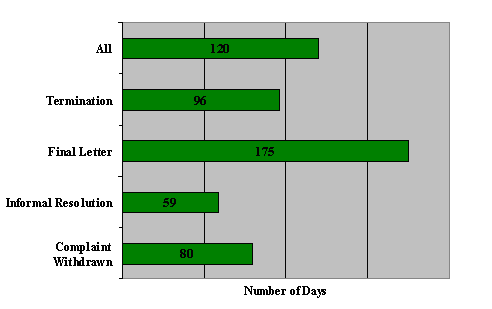
Complaint timelines were also determined by allegation type. For the three most common types of allegations, i.e. "Neglect of Duty", "Improper Attitude" and "Improper Use of Force", timelines are reported.
- Allegations of "Neglect of Duty" took 102 days for a disposition to be issued (range: 0 to 283 days). Typically, complainants waited 221 days after the incident date to lodge the original complaint (range: 0 to 2,402 days) for this type of allegation.
- Allegations of "Improper Attitude" took 113 days for a disposition to be issued (range: 0 to 392 days). Complainants, on average, lodged the original complaint 111 days after the incident date (range: 0 to 2,402 days) for this type of allegation.
- Allegations of "Improper Use of Force" typically took 191 days for a disposition to be issued once a complaint was lodged (range: 29 to 396 days). On average, complainants waited 101 days to lodge the original complaint (range: 0 to 1,173 days) for this type of allegation.
It is interesting to note that within "K" Division complaints involving "Statutory Offence" allegations, on average, took the longest time (197 days) to issue dispositions by the RCMP in this division.
L-Prince Edward Island
Complaints Received
The Commission received 9 complaint dispositions from "L" Division related to complaints lodged in 2007. Of the 9 complaints received 67% were lodged with the RCMP, while 33% were lodged with the Commission.
"L" Division: Number of Complaints Based on the Organization it Was Lodged With
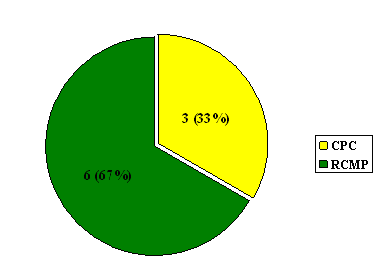
The average number of members named in the complaints for "L" Division was 1.0, with the rank of constable (77%) being the most commonly represented rank. The rank of sergeant, and staff sergeant were only represented once in each of the complaints.
"L" Division: Number of Complaints by Member Rank
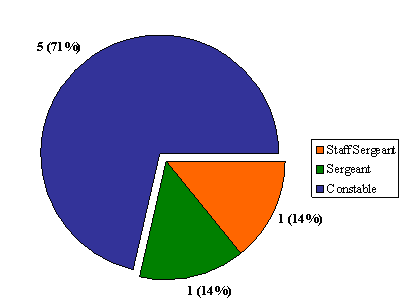
Allegations
A total of 10 allegations were made against members in "L" Division, which averaged about 1.1 allegations per complaint. The prevalent allegations included "Improper Attitude" (40%), and "Neglect of Duty" (30%).
"L" Division: Allegations Breakdown
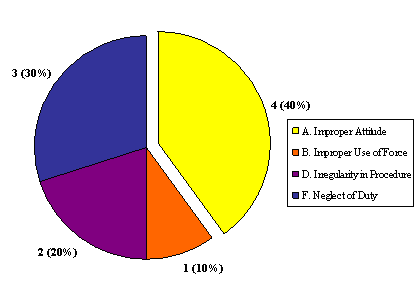
Allegations were further analyzed by member rank. In "L" Division, "Improper Attitude" was the most common allegation against constables (80%).
For every complaint disposition received, the Commission analyzed the reason and incident details in order to identify issues related to the nature of the complaint. By cross-referencing these issues with the RCMP allegations, the Commission was able to identify key issues that come up for each allegation. The common issues identified in the complaints were "Attitude" (29%), "Criminal Investigation Quality (RCMP)" (14%) and "Vehicular Incidents" (14%).
| Issue | Number of Complaints | % |
|---|---|---|
| Attitude | 4 | 28.6% |
| Criminal Investigation Quality (RCMP) | 2 | 14.3% |
| Crowd Control | 1 | 7.1% |
| Entry of Premises | 1 | 7.1% |
| Impairment | 1 | 7.1% |
| Police Physical Abuse | 1 | 7.1% |
| Property Mishandling | 1 | 7.1% |
| Release/Disclosure of Information | 1 | 7.1% |
| Vehicular Incidents | 2 | 14.3% |
| Total | 14 |
Further, the results revealed trends in the issues for each allegation. For the purpose of this analysis, the common issues will be reported for the three most frequently occurring allegations: "Neglect of Duty", "Improper Attitude" and "Improper Use of Force".
For complaints alleging "Neglect of Duty" the key issue was "Criminal Investigation Quality (RCMP)" (40%). The main issues identified in complaints alleging "Improper Attitude" included "Attitude" (67%). Finally, in complaints involving allegations of "Improper Use of Force" only two issues were identified, bearing equal importance: "Crowd Control" (50%) and "Police Physical Abuse" (50%).
Finally, the allegations were also examined by disposition type. In all of the complaints involving the three common allegations, i.e. "Neglect of Duty" (100%), "Improper Attitude" (100%) and "Improper Use of Force" (100%), a Final Report was issued.
Disposition of Complaints
Investigation and Final Report
Of the complaint dispositions the Commission received, 100% were formally investigated and a Final Report issued by the RCMP. These reports made determinations on 10 allegations. In total, 90% of the RCMP's findings did not support the complainant's allegations. Further, for every type of allegation addressed in the complaints, the overwhelming majority (67-100%) of the RCMP's findings did not support the complainant's allegation(s).
The allegation most likely to be subject to a Final Report was "Improper Attitude".
Informal Resolutions
The Commission did not receive any complaint dispositions from "L" Division that contained an informal resolution.
Withdrawals
The Commission did not receive any complaint dispositions from "L" Division that contained a complaint withdrawal.
Terminations (Notice of Direction)63
The Commission did not receive any complaint dispositions from "L" Division where a Notice of Direction had been issued.
Service Standards: Complaint Processing Time
In 2007, "L" Division, on average, took 114 days to issue a disposition once a complaint was lodged (range: 26 to 292 days). This is in comparison to the RCMP national average of 114 days to issue a disposition once a complaint was lodged (range: 0 to 447 days). Surprisingly, it typically took 482 days for a complainant to lodge the original complaint (range: 22 to 2,184 days). Since the Commission received only one type of disposition from "L" Division, it is not possible to compare the timelines for the different dispositions.
"L" Division: Complaint Timeline by Organization it Was Lodged With
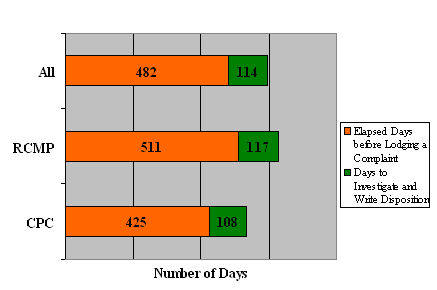
The average number of days to issue a disposition was 108 days for Commission-lodged complaints (range: 26 to 263 days) as opposed to 117 days for RCMP-lodged complaints (range: 38 to 292 days). On average, complainants waited 425 days after the incident took place before lodging the original complaint with the Commission (range: 92 to 974 days), while complaints lodged with the RCMP averaged 511 days after the incident (range: 22 to 2,184 days).64
Independent of the public complaint processing timelines, the Review of the Record Project required the RCMP to provide the Commission copies of all dispositions for its analyses. To that end, the average number of days for the Commission to receive the complaint disposition from this division was 122 for Commission-lodged complaints (range: 6 to 242 days) as opposed to the 33 days it took for RCMP-lodged complaints (range: 6 to 90 days).
Complaint timelines were also determined by allegation type. For the three most common types of allegations, i.e. "Neglect of Duty", "Improper Attitude" and "Improper Use of Force", timelines are reported.
- Allegations of "Neglect of Duty", on average, took 43 days for a disposition to be issued (range: 26 to 70 days). Typically, complainants waited almost one year (346 days) after the incident date to lodge the original complaint (range: 92 to 738 days) for this type of allegation.
- Allegations of "Improper Attitude", on average, took 133 days for a disposition to be issued (range: 38 to 292 days). Complainants, on average, lodged the original complaint 573 days after the incident date (range: 22 to 2,184 days) for this type of allegation.
- Allegations for "Improper Use of Force" typically took 263 days for a disposition to be issued once a complaint was lodged (range: 263 to 263 days).
It is interesting to note that within "L" Division complaints involving "Statutory Offence" allegations, on average, took the longest time (263 days) to issue dispositions.
M-Yukon
Complaints Received
The Commission received 28 complaint dispositions from "M" Division of which 18 (64%) of the complaints were lodged with the RCMP and 10 (36%) were lodged with the Commission.
"M" Division: Number of Complaints Based on the Organization it Was Lodged With
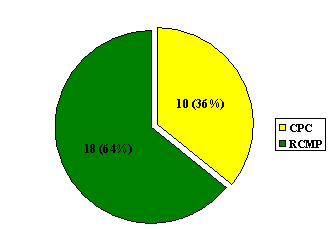
The detachments that were identified the most often in complaint dispositions included Whitehorse Headquarters (57%), followed by the Haines Junction Detachment (14%). In comparing the two detachments, it was found that for Whitehorse Headquarters, 8 (50%) of the complaints were lodged with the RCMP, while 8 (50%) were lodged with the Commission; for the Haines Junction Detachment, 4 (100%) of the complaints were lodged with the RCMP while none of the complaints were filed with the Commission.
The average number of members named in the complaints for "M" Division was 1.8, with constables (23%) being the most frequently represented rank in the complaints, followed by the rank of corporal (23%).
"M" Division: Number of Complaints by Member Rank
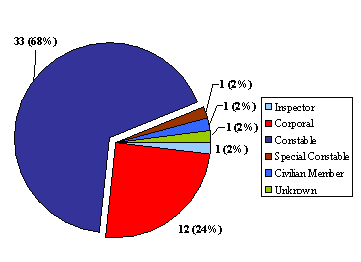
Allegations
A total of 86 allegations were made, which averaged about 3.1 allegations per complaint. The common allegations were "Improper Attitude" (26%), "Improper Use of Force" (26%), "Oppressive Conduct" (16%) and "Neglect of Duty" (11%).
"M" Division: Allegations Breakdown
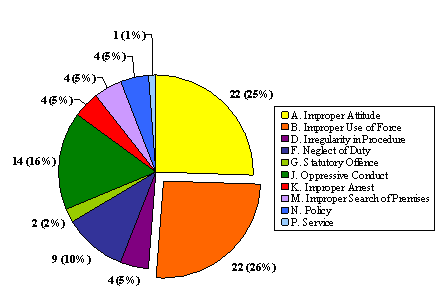
Allegations were further examined at the detachment level. For Whitehorse Headquarters, the results indicate that most of the allegations related to "Improper Use of Force" (27%), followed by "Improper Attitude" (25%), "Oppressive Conduct" (19%) and "Neglect of Duty" (13%). The common allegations from the Haines Junction Detachment were "Improper Use of Force" (25%), "Irregularity in Procedure" (25%) and "Statutory Offence" (25%).
In "M" Division RCMP, of all the allegations made against constables and corporals, allegations of "Improper Attitude", "Improper Use of Force" and "Oppressive Conduct" were frequently made against both ranks. Specifically, for constables the most frequent allegation was "Improper Use of Force" (25%), followed by "Improper Attitude" (24%) and "Oppressive Conduct" (18%). The most common allegation made against the rank of corporal was "Improper Attitude" (36%), followed by "Improper Use of Force" (29%) and "Oppressive Conduct" (14%). It is interesting to note that one allegation of "Improper Use of Force" was made against the rank of inspector, given that this type of allegation is typical of members involved in front-line policing.
For every complaint disposition received, the Commission analyzed the reason and incident details in order to identify issues related to the nature of the complaint. By cross-referencing these issues with the RCMP allegations, the Commission was able to identify key issues that come up for each allegation. The most common issue identified in the complaints for "M" Division was "Attitude" (24%), followed by "Arrest" (11%), "Police Physical Abuse" (9%), "Detention" (7%) and "Vehicular Incidents" (6%).
| Issue | Number of Complaints | % |
|---|---|---|
| Aboriginal community | 1 | 1.4% |
| Abusive Language | 2 | 2.9% |
| Arrest | 8 | 11.4% |
| Attitude | 17 | 24.3% |
| Care in Custody | 2 | 2.9% |
| Chemical Irritant | 1 | 1.4% |
| Child Custody | 1 | 1.4% |
| Criminal Investigation Quality (RCMP) | 3 | 4.3% |
| Detention | 5 | 7.1% |
| Entry of Premises | 3 | 4.3% |
| Impairment | 3 | 4.3% |
| Lethal Weapons | 1 | 1.4% |
| Lying under Oath | 1 | 1.4% |
| Medical Care | 1 | 1.4% |
| Mental Illness | 1 | 1.4% |
| Non-lethal weapons other than chemical irritants | 1 | 1.4% |
| Non-spousal, Non-child Assault Response | 1 | 1.4% |
| Other (if necessary) | 1 | 1.4% |
| Police Physical Abuse | 6 | 8.6% |
| Property Mishandling | 2 | 2.9% |
| Right to Counsel | 2 | 2.9% |
| Search | 1 | 1.4% |
| Seizure | 1 | 1.4% |
| Service | 1 | 1.4% |
| Vehicular Incidents | 4 | 5.7% |
| Total | 70 |
Trends in the issues were also identified by detachment. For the Whitehorse Headquarters, the common issues that the Commission identified in the complaint were "Attitude" (25%), "Arrest" (11%), "Detention" (9%), and "Police Physical Abuse" (9%). No trends could be identified in the complaints from the Whitehorse Detachment because the results were insignificant.
Further, the results revealed trends in the issues for each allegation. For the purpose of this analysis, the common issues will be reported for the most frequently occurring allegations: "Improper Attitude", "Improper Use of Force", "Oppressive Conduct" and "Neglect of Duty".
- For complaints alleging "Improper Attitude" the key issues were "Attitude" (33%), "Police Physical Abuse" (16%), "Abusive Language" (11%) and "Arrest" (11%).
- Complaints alleging "Improper Use of Force" included "Arrest" (19%), "Attitude" (13%) and "Detention" (12%). The key issues in complaints involving allegations of "Oppressive Conduct" include "Attitude" (16%) and "Arrest" (15%).
- For complaints alleging "Neglect of Duty" the most common issue identified by the Commission was "Attitude" (18%), followed by "Arrest" (14%), and "Criminal Investigation Quality (RCMP)" (11%), "Entry of Premises" (11%), "Property Mishandling" (11%) and "Search" (11%).
Disposition of Complaints
"M" Division: Number of Complaints by Disposition Type
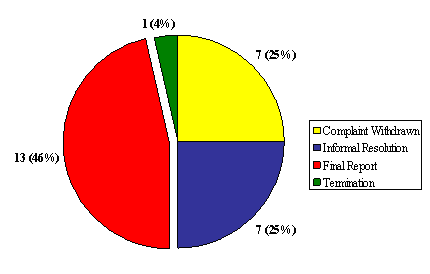
Investigation and Final Report
Of the complaint dispositions the Commission received from "M" Division, 13 (46%) were formally investigated and a Final Report issued by the RCMP. These reports made determinations on 44 allegations, with the most common being "Improper Use of Force".
At the detachment level, Final Reports accounted for:
- 8 of the 16 complaint dispositions received from the Whitehorse Detachment; and
- 3 of the 4 complaint dispositions received from the Haines Junction Detachment.
The majority of the RCMP's findings (98%) did not support the complainant's allegation(s), while only 2% of the findings were in support of the complainant's allegation(s). For each type of allegation, with the exception of "Service" the overwhelming majority (68-100%) of the RCMP's findings did not support the complainant's allegation(s). There was only one allegation of "Service"; therefore, this finding should be interpreted accordingly.
Informal Resolutions
Complaints were informally resolved in 25% of the dispositions received from "M" Division. In total, 8 allegations were informally resolved, and were most often allegations of "Improper Attitude".
At the detachment level, informal resolutions accounted for:
- 2 (13%) complaint dispositions from the Whitehorse Headquarters; and
- none of the complaints were informally resolved from the Haines Junction Detachment.
Withdrawals
In 25% of the cases, the complainant withdrew the complaint, which disposed of 16 allegations in total. The most common allegation withdrawn was "Oppressive Conduct".
At the detachment level, withdrawals accounted for:
- 6 (38%) complaint dispositions from the Whitehorse Headquarters; and
- none of the dispositions received from the Haines Junction Detachment.
Terminations (Notice of Direction)65
In 2007, in 4% of all public complaints received from "M" Division, a Notice of Direction was issued, in which the termination paragraph (c) was specified. In total, 2 allegations relating to "Statutory Offence" were subject to termination paragraph (c).
Service Standards: Complaint Processing Time
In 2007, "M" Division, on average, took 99 days to issue a disposition once a complaint was lodged (range: 1 to 304 days). This is in comparison to the RCMP national average of 114 days to issue a disposition once a complaint was lodged (range: 0 to 447 days). It typically took close to just over two months (66 days) for a complainant to lodge the original complaint (range: 0 to 644 days).
"M" Division: Complaint Timeline by Organization it Was Lodged With
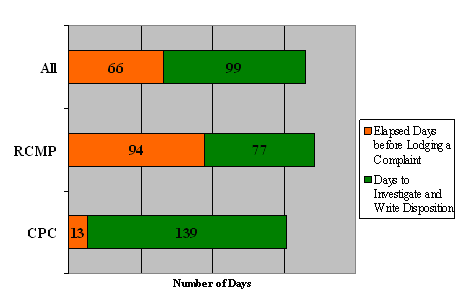
The average number of days to issue a disposition was 139 for Commission-lodged complaints (range: 13 to 304 days) as opposed to 77 days for RCMP-lodged complaints (range: 1 to 182 days). On average, complainants waited 13 days after the incident took place before lodging a complaint with the Commission (range: 0 to 55 days), while complaints lodged with the RCMP averaged 94 days after the incident (range: 0 to 644 days).66
Independent of the public complaint processing timelines, the Review of the Record Project required the RCMP to provide the Commission copies of all dispositions for its analyses. To that end, the average number of days for the Commission to receive the complaint disposition from this division was 56 for Commission-lodged complaints (range: 7 to 197 days) as opposed to the 38 days it took for RCMP-lodged complaints (range: 6 to 168 days).
Complaint processing times were analyzed for each of the two detachments with the most complaints:
- Whitehorse Headquarters took 110 days to issue a disposition once a complaint was lodged (range: 1 to 304 days). Typically, for these cases complainants waited 17 days after the incident date to lodge the original complaint (range: 0 to 71 days).
- The Haines Junction Detachment took an average of 137 days to issue a disposition once a complaint was lodged (range: 67 to 182 days). Complainants, on average, lodged the original complaint 321 days after the incident date (range: 31 to 644 days).
Complaint timelines were also determined by disposition type:
- To issue a Final Report by the RCMP it took 124 days (range: 43 to 197 days). For these cases, it generally took 63 days to elapse before a complainant lodged the original complaint that resulted in this type of disposition (range: 1 to 362 days).
- To issue a Notice of Direction invoking any termination provision it took 172 days. For these cases, it generally took 644 days to elapse before a complainant lodged the original complaint that resulted in this type of disposition.
- To capture a withdrawal it took an average of 102 days (range: 1 to 304 days). For these cases, it generally took 14 days to elapse before a complainant lodged the original complaint that resulted in this type of disposition (range: 0 to 71 days).
- To enter into an informal resolution it took, on average, 40 days (range: 1 to 138 days). For these cases, it generally took 39 days to elapse before a complainant lodged the original complaint that resulted in this type of disposition (range: 2 to 133 days).
"M" Division: Number of Days to Issue the Disposition by Disposition Type
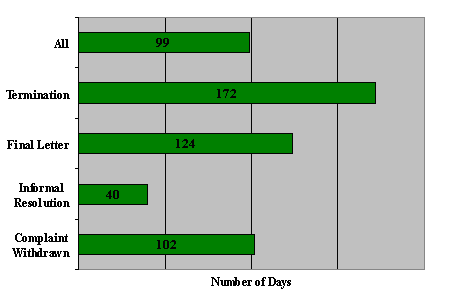
Complaint timelines were also determined by allegation type. For the four common types of allegations, i.e. "Improper Attitude", "Improper Use of Force", "Oppressive Conduct" and "Neglect of Duty", timelines are reported.
- Allegations of "Improper Attitude", on average, took 77 days for a disposition to be issued (range: 1 to 119 days). Typically, complainants waited 28 days after the incident date to lodge the original complaint (range: 1 to 119 days) for this type of allegation.
- Allegations of "Improper Use of Force", on average, took 147 days for a disposition to be issued (range: 121 to 185 days). Complainants, on average, lodged the original complaint 37 days after the incident date (range: 0 to 248 days) for this type of allegation.
- Allegations of "Oppressive Conduct", on average, took 143 days for a disposition to be issued once a complaint was lodged (range: 21 to 304 days). On average, complainants waited 21 days to lodge the original complaint (range: 0 to 119 days) for this type of allegation.
- Allegations of "Neglect of Duty" typically took 110 days for a disposition to be issued (range: 7 to 304 days). Complainants waited, on average, 34 days after the incident date to file the original complaint (range: 2 to 133 days) for this type of allegation.
It is interesting to note that within "M" Division, complaints involving "Statutory Offence" allegations, on average, took the longest time (172 days) to issue dispositions. This finding was surprising given that complaints involving this type of allegation were all disposed of through a Notice of Direction.
O-Ontario
Complaints Received
The Commission received 13 complaint dispositions of which 7 (55%) were lodged with the RCMP, while 6 (46%) were lodged with the Commission.
"O" Division: Number of Complaints Based on the Organization it Was Lodged With
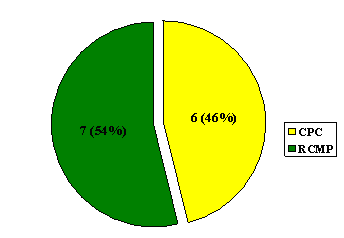
The average number of members named in the complaint for "O" Division was 1.2. Given that most front-line policing within the RCMP is done by constables and corporals, it is surprising that the rank of Sergeant (19%) was more frequently represented in the complaints than constables (13%) and corporals (13%), compared to the other ranks. However, in six instances (38%) the subject member's rank was not identified, which may account for more constables and corporals.
"O" Division: Number of Complaints by Member Rank
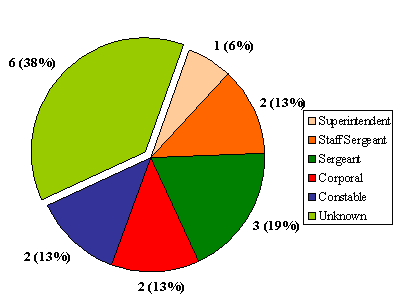
Allegations
A total of 17 allegations were made against members in "O" Division, which averaged about 1.3 allegations per complaint. Frequent allegations included "Oppressive Conduct"(41%); and "Improper Attitude" (24%).
"O" Division: Allegations Breakdown
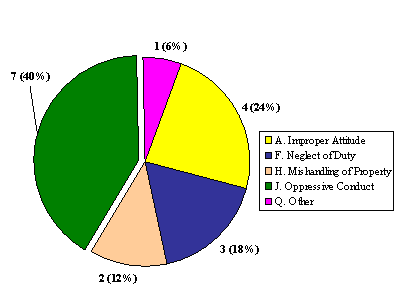
When broken down into rank "Oppressive Conduct" (67%) was the most common allegation made against sergeants, the most frequently represented rank in the complaints.
For every complaint disposition received, the Commission analyzed the reason and incident details in order to identify issues related to the nature of the complaint. By cross-referencing these issues with the RCMP allegations, the Commission was able to identify key issues that come up for each allegation. The typical issues raised in the complaints for "O" Division were "Attitude" (22%), "Mental Illness" (20%), "Criminal Investigation Quality (RCMP)" (11%) and "Public Complaint Process Quality (RCMP)" (11%).
| Issue | Number of Complaints | % |
|---|---|---|
| Abusive Language | 1 | 5.6% |
| Attitude | 4 | 22.2% |
| Criminal Investigation Quality (RCMP) | 2 | 11.1% |
| Mental Illness | 4 | 22.2% |
| Police Dogs | 1 | 5.6% |
| Property Mishandling | 1 | 5.6% |
| Public Complaint Process Quality (RCMP) | 2 | 11.1% |
| Release/Disclosure of Information | 1 | 5.6% |
| Seizure | 1 | 5.6% |
| Spousal Abuse Response | 1 | 5.6% |
| Total | 18 |
Further, the results revealed trends in the issues for each allegation. For the purpose of this analysis, the common issues will be reported for the two most frequently occurring allegations: "Oppressive Conduct" and "Improper Attitude". The primary issue identified in complaints pertaining to "Oppressive Conduct" included "Mental Illness" (44%) and "Public Complaint Process Quality (RCMP" (22%). For complains involving allegations of "Improper Attitude" the main issue was "Attitude" (60%).
The allegations were also examined by disposition type. For complaints involving allegations of "Oppressive Conduct", in most cases (86%), a Notice of Direction was issued. Similarly, for complaints involving allegations of "Improper Attitude", it was common (50%) for "O" Division RCMP to issue a Notice of Direction.
Disposition of Complaints
"O" Division: Number of Complaints by Disposition Type

Investigation and Final Report
Of the complaint dispositions the Commission received from "O" Division, most (31%) were formally investigated and a Final Report issued by the RCMP. These reports made determinations on 6 allegations. Allegations most likely to be subject to a Final Report were "Neglect of Duty" and "Mishandling of Property". All of the RCMP's findings in all of the Final Reports did not support the complainant's allegations.
Informal Resolutions
Informal resolutions occurred in 8% of the cases. In total, 1 allegation of "Improper Attitude" was informally resolved.
Withdrawals
In 8% of the cases received by the Commission, the complainant withdrew the complaint. In total, 1 allegation of "Neglect of Duty" was withdrawn.
Terminations (Notice of Direction)67
In 2007, the majority (54%) of all public complaints received from "O" Division were issued a Notice of Direction, addressing 9 allegations.
"O" Division: Number of Terminated Complaint by Grounds Identified by subsection 45.36(5) of the RCMP Act
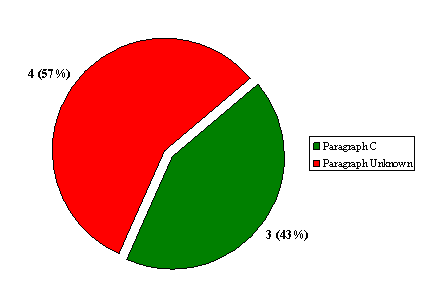
The allegation most likely to be subject to a termination paragraph was "Oppressive Conduct". In most cases (57%), the grounds for termination was not specified in the Notice of Direction
Service Standards: Complaint Processing Time
On average, "O" Division took 69 days to issue a disposition once a complaint was lodged (range: 3 to 236 days). This is in comparison to the RCMP national average of 114 days to issue a disposition once a complaint was lodged (range: 0 to 447 days). It typically took over two years (759 days) for a complainant to lodge the original complaint (range: 0 to 2,932 days).
"O" Division: Complaint Timeline by Organization it Was Lodged With
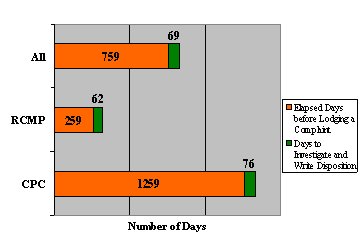
The average number of days to issue a disposition was 76 for Commission-lodged complaints (range: 28 to 215 days) as opposed to 62 days for RCMP-lodged complaints (range: 3 to 236 days). On average, complainants waited 1,259 days after the incident took place before lodging a complaint with the Commission (range: 0 to 2,932 days), while complaints lodged with the RCMP averaged 259 days after the incident (range: 0 to 1,011 days).68
Independent of the public complaint processing timelines, the Review of the Record Project required the RCMP to provide the Commission copies of all dispositions for its analyses. To that end, the average number of days for the Commission to receive the complaint disposition from this Division was 104 for Commission-lodged complaints (range: 9 to 250 days) as opposed to the 98 days it took for RCMP-lodged complaints (range: 2 to 250 days).
Complaint timelines were also determined by disposition type:
- To issue a Final Report by the RCMP it took 113 days (range: 44 to 215 days). For these cases, it generally took 597 days to elapse before a complainant lodged the original complaint that resulted in this type of disposition (range: 0 to 2,361 days).
- To issue a Notice of Direction invoking any termination provision it took 55 days (range: 3 to 236 days). For these cases, it generally took 1,118 days for a complainant to lodge a complaint that resulted in this type of disposition (range: 92 to 2,932 days).
- To issue a withdrawal it took 53 days. For these cases, it generally took 7 days to elapse before a complainant lodged the original complaint that resulted in this type of disposition.
- To enter into an informal resolution it took, on average, 6 days. For these cases, it generally took 3 days to elapse before a complainant lodged the original complaint that resulted in this type of disposition.
"O" Division: Number of Days to Issue the Disposition by Disposition Type
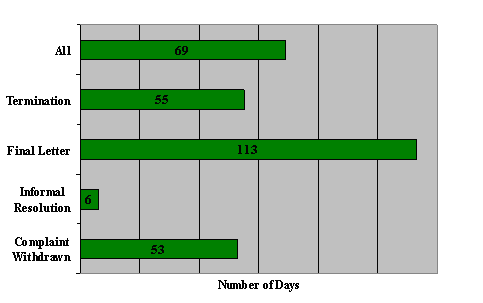
Complaint timelines were also determined by allegation type. For the most common types of allegations, i.e. "Oppressive Conduct" and "Improper Attitude" timelines are reported.
- Allegations of "Oppressive Conduct", on average, took just under a month (27 days) for a disposition to be issued (range: 3 to 44 days). Typically, for these cases complainants waited 1,244 days after the incident date to lodge the original complaint (range: 27 to 2,932 days) for this type of allegation.
- Allegations of "Improper Attitude" on average took 92 days for a disposition to be issued (range: 6 to 236 days). Complainants, on average, lodged the original complaint 129 days after the incident date (range: 0 to 419 days) for this type of allegation.
It is interesting to note that within "O" Division complaints involving "Mishandling of Property" allegations, on average, took the longest time (215 days) to issue dispositions.
V-Nunavut
Complaints Received
The Commission received 17 complaint dispositions from "V" Division of which 11 (65%) were lodged with the Commission, while 6 (35%) were lodged with the RCMP.
"V" Division: Number of Complaints Based on the Organization it Was Lodged With
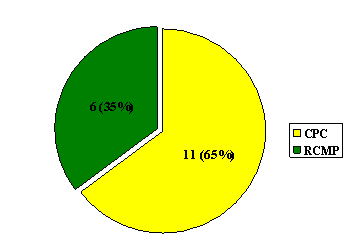
The complaint dispositions were further examined at the detachment level. The detachments that were most often mentioned in the complaint dispositions were Gjoa Haven Detachment (24%), followed by the Rankin Inlet Detachment (18%). In comparing the two detachments, it was found that for the Gjoa Haven Detachment, 2 (50%) of the complaints were lodged with the RCMP, and 2 (50%) were also lodged with the Commission. For the Rankin Inlet Detachment, 2 (67%) of the complaints were lodged with the RCMP, while 1 (33%) was lodged with the Commission.
The average number of members named in the complaints for "V" Division was 1.4 with the rank of constable (59%) being the most commonly rank followed by the rank of corporal (29%).
"V" Division: Number of Complaints by Member Rank
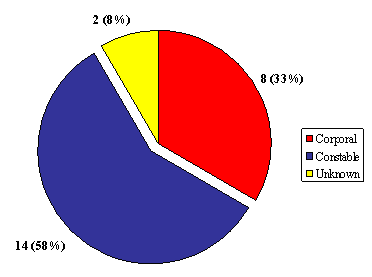
Allegations
A total of 35 allegations were made against members in "V" Division, which averaged about 2.1 allegations per complaint. The most common allegations were "Improper Use of Force" (29%), "Neglect of Duty" (14%), "Improper Attitude" (11%) and "Improper Arrest" (11%).
"V" Division: Allegations Breakdown
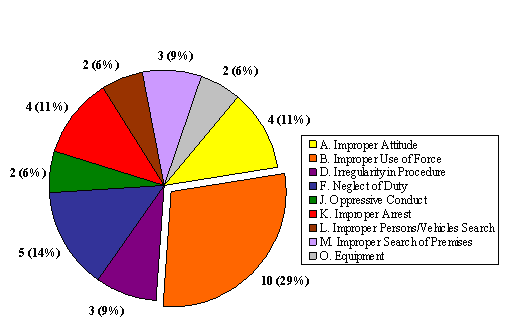
Allegations were also examined at the detachment level. For the Gjoa Haven Detachment, the results indicate that the most common allegations were "Improper Use of Force" (29%) and "Improper Arrest" (29%). The frequencies of allegations from the Rankin Inlet Detachment were not meaningful enough to report trends.
In "V" Division RCMP, the most common allegation against constables was "Improper Use of Force" (36%), followed by "Improper Attitude" (14%), "Irregularity in Procedure" (14%), "Neglect of Duty" (14%) and "Improper Arrest" (14%). For the rank of corporal, the most common allegation was also "Improper Use of Force" (36%), then "Neglect of Duty" (18%) and "Improper Search of Premises" (18%).
For every complaint disposition received, the Commission analyzed the reason and incident details in order to identify issues related to the nature of the complaint. By cross-referencing these issues with the RCMP allegations, the Commission was able to identify key issues that come up for each allegation. The most common issue that the Commission identified in complaints from "V" Division was "Police Physical Abuse" (15%), followed by "Arrest" (12%) and "Attitude" (12%).
| Issue | Number of Complaints | % |
|---|---|---|
| Arrest | 4 | 11.8% |
| Attitude | 4 | 11.8% |
| Care in Custody | 1 | 2.9% |
| Chemical Irritant | 1 | 2.9% |
| Criminal Investigation Quality (RCMP) | 1 | 2.9% |
| Detention | 1 | 2.9% |
| Entry of Premises | 3 | 8.8% |
| Impairment | 3 | 8.8% |
| Medical Care | 1 | 2.9% |
| Non-spousal, Non-child Assault Response | 1 | 2.9% |
| Police Physical Abuse | 5 | 14.7% |
| Release/Disclosure of Information | 1 | 2.9% |
| Restraints | 1 | 2.9% |
| Search | 2 | 5.9% |
| Service | 3 | 8.8% |
| Vehicular Incidents | 2 | 5.9% |
| Total | 34 |
Trends in the issues were also identified by detachment. For the Gjoa Haven Detachment, the most common issue identified in the complaints was "Vehicular Incidents" (29%). Trends in the issues could not be identified for the Rankin Inlet Detachment because only two issues were identified in the complaints.
Further, the results revealed trends in the issues for each allegation. For the purpose of this analysis, the common issues will be reported for the most frequently occurring allegations: "Improper Use of Force", "Neglect of Duty", "Improper Attitude" and "Improper Arrest".
- For allegations of "Improper Use of Force" the key issues were "Police Physical Abuse", "Arrest," "Care in Custody", "Impairment" and "Service".
- For allegations of "Neglect of Duty" the key issues were "Arrest" (17%), "Care in Custody" (17%), "Police Physical Abuse" (17%) and "Service" (17%).
- For allegations of "Improper Attitude" the key issue was "Attitude" (80%).
- For allegations of "Improper Arrest" there were no significant results.
Disposition of Complaints
"V" Division: Number of Complaints by Disposition Type
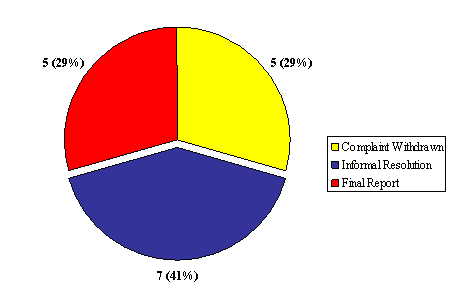
Investigation and Final Report
Of the complaint dispositions the Commission received from "V" Division RCMP, 5 (29%) were formally investigated and a Final Report issued by the RCMP. These reports made determinations on 13 allegations, the most common of which was "Improper Search of Premises". The results show that all of the RCMP's findings in the Final Report did not support any of the complainant's allegations.
Informal Resolutions
Accounting for the most common way to dispose of a complaint, informal resolutions occurred in 41% of the cases, disposing of 15 allegations. The most common allegation to be informally resolved was "Improper Use of Force"; in 40% of the cases this allegation was resolved in this manner. This is not only significantly above the Force wide average but also raised concern within the Commission that these types of allegations are being informally resolved too frequently.
At the detachment level, informal resolutions accounted for:
- 3 out of the 4 complaint dispositions received from the Gjoa Haven Detachment (75%); and
- 2 out of the 3 complaint dispositions received from the Rankin Inlet Detachment (67%).
Withdrawals
In 29% of the cases, the complainant withdrew the complaint, which disposed of 7 allegations. The most common of these allegations was "Improper Use of Force".
Allegations of "Improper Use of Force" accounted for 40% of the withdrawals for this time period, which is not only significantly above the Force-wide average, but also raised concern within the Commission that these types of allegations are being informally resolved too often.
Terminations (Notice of Direction)69
In 2007, the Commission did not receive any Notice of Directions from "V" Division.
Service Standards: Complaint Processing Time
In 2007 "V" Division, on average, took 92 days to issue a disposition once a complaint was lodged (range: 1 to 333 days). This is in comparison to the RCMP national average of 114 days to issues a disposition once a complaint was lodged (range: 0 to 447 days). It typically took just over one month (39 days) for a complainant to lodge a complaint (range: 0 to 199 days).
"V" Division: Complaint Timeline by Organization it Was Lodged With
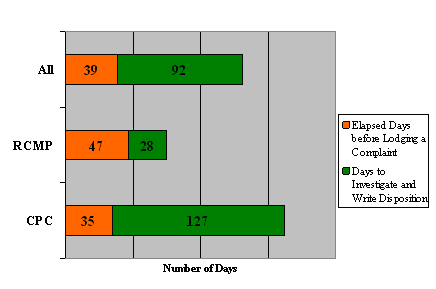
The average number of days to issue a disposition was 127 for Commission-lodged complaints (range: 28 to 333 days) as opposed to 28 days for RCMP-lodged complaints (range: 1 to 60 days). On average, complainants waited 35 days after the incident took place before lodging a complaint with the Commission (range: 0 to 175 days), while complaints lodged with the RCMP averaged 47 days after the incident (range: 0 to 199 days).70
Independent of the public complaint processing timelines, the Review of the Record Project required the RCMP to provide the Commission copies of all dispositions for its analyses. To that end, the average number of days for the Commission to receive the complaint disposition from this division was 182 for Commission-lodged complaints (range: 11 to 365 days) as opposed to the 153 days it took for RCMP-lodged complaints (range: 113 to 224 days).
Complaint processing times were analyzed for each of the two detachments that were identified most often in the public complaints:
- The Gjoa Haven Detachment took on average 65 days to issue a disposition once a complaint was lodged (range: 17 to 104 days). Typically, complainants waited close to two months (54 days) after the incident date to lodge the original complaint (range: 4 to 175 days).
- The Rankin Inlet Detachment took on average 18 days to issue a disposition once a complaint was lodged (range: 1 to 47 days). Complainants, on average, lodged a complaint 69 days after the incident date (range: 0 to 199 days).
Complaint timelines were also determined by disposition type:
- To issue a Final Report by the RCMP it took 179 days (range: 60 to 333 days). For these cases, it generally took 17 days to elapse before a complainant lodged the original complaint that resulted in this type of disposition (range: 5 to 54 days).
- To issue a withdrawal it took an average of 67 days to issue a disposition (range; 1 to 174 days). For these cases, it generally took 64 days to elapse before a complainant lodged the original complaint that resulted in this type of disposition (range: 0 to 199 days).
- To enter into an informal resolution it took 48 days (range: 5 to 104 days). For these cases, it generally took 37 days to elapse before a complainant lodged the original complaint that resulted in this type of disposition (range: 0 to 175 days).
"V" Division: Number of Days to Issue the Disposition by Disposition Type
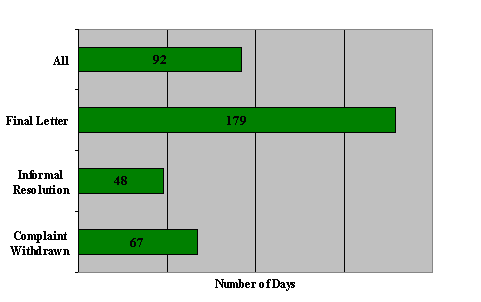
Complaint timelines were also determined by allegation type. For the four common types of allegations, i.e. "Improper Use of Force", "Neglect of Duty", "Improper Attitude" and "Improper Arrest", timelines are reported.
- For allegations of "Improper Use of Force", on average, it took 138 days for a disposition to be issued (range: 28 to 333 days). Typically, complainants waited 27 days after the incident date to lodge the original complaint (range: 4 to 69 days) for this type of allegation.
- For allegations of "Neglect of Duty", on average, it took 40 days for a disposition to be issued (range: 1 to 87 days). Complainants, on average, lodged the original complaint 64 days after the incident date (range: 0 to 199 days) for this type of allegation.
- For allegations of "Improper Attitude", it typically took 40 days for a disposition to be issued once a complaint was lodged (range: 5 to 78 days). On average, complainants waited 52 days to lodge the original complaint (range: 0 to 175 days) with this type of allegation.
- For allegations of "Improper Arrest", it took the RCMP an average of 119 days for a disposition to be issued (range: 104 to 133 days). Complainants, on average, waited one week (7 days) after the incident date to lodge the original complaint (range: 4 to 10 days) with this type of allegation.
It is interesting to note that within "V" Division complaints involving "Improper Persons/Vehicles Search" allegations, on average, took the longest time (148 days) to issue dispositions.
38 The RCMP may decide to terminate a complaint under three strict grounds provided for in paragraphs (a), (b) and (c) of subsection 45.36(5) of the RCMP Act. These paragraphs are:
- (a) the complaint is one that could more appropriately be dealt with, initially or completely, according to a procedure provided under any other Act of Parliament;
- (b) the complaint is trivial, frivolous, vexatious or made in bad faith; and
- (c) having regard to all the circumstances, investigation or further investigation is not necessary or reasonably practicable.
39 While the reasons for this delay is not yet fully understood, some preliminary analysis of the data suggests that complainants wait extended periods of time to lodge complaints with the Commission because: 1) the types of allegations that are lodged with the Commission tend to be more serious in nature than those lodged with the RCMP; 2) the complainant may not have immediate access to the public complaint system; 3) the complaint may be historical in that an incident occurred many years (in some cases decades) before a formal complaint is lodged; and 4) alternate ways of resolving the complaint may have been attempted before a formal complaint was lodged.
40 There is less than 1 allegation per complaint, as many complaints against the RCMP as a whole are lodged with "A" Division.
41 The RCMP may decide to terminate a complaint under three strict grounds provided for in paragraphs (a), (b) and (c) of subsection 45.36(5) of the RCMP Act. These paragraphs are:
- (a) the complaint is one that could more appropriately be dealt with, initially or completely, according to a procedure provided under any other Act of Parliament;
- (b) the complaint is trivial, frivolous, vexatious or made in bad faith; and
- (c) having regard to all the circumstances, investigation or further investigation is not necessary or reasonably practicable.
42 While the reasons for this delay is not yet fully understood, some preliminary analysis of the data suggests that complainants wait extended periods of time to lodge complaints with the Commission because: 1) the types of allegations that are lodged with the Commission tend to be more serious in nature than those lodged with the RCMP; 2) the complainant may not have immediate access to the public complaint system; 3) the complaint may be historical in that an incident occurred many years (in some cases decades) before a formal complaint is lodged; and 4) alternate ways of resolving the complaint may have been attempted before a formal complaint was lodged. Specific to this number, one complainant waited over 4,200 days to lodge a formal complaint with the Commission.
43 The RCMP may decide to terminate a complaint under three strict grounds provided for in paragraphs (a), (b) and (c) of subsection 45.36(5) of the RCMP Act. These paragraphs are:
- (a) the complaint is one that could more appropriately be dealt with, initially or completely, according to a procedure provided under any other Act of Parliament;
- (b) the complaint is trivial, frivolous, vexatious or made in bad faith; and
- (c) having regard to all the circumstances, investigation or further investigation is not necessary or reasonably practicable.
44 While the reasons for this delay is not yet fully understood, some preliminary analysis of the data suggests that complainants wait extended periods of time to lodge complaints with the Commission because: 1) the types of allegations that are lodged with the Commission tend to be more serious in nature than those lodged with the RCMP; 2) the complainant may not have immediate access to the public complaint system; 3) the complaint may be historical in that an incident occurred many years (in some cases decades) before a formal complaint is lodged; and 4) alternate ways of resolving the complaint may have been attempted before a formal complaint was lodged. In this case, a complainant waited over 3,700 days before lodging a formal complaint with the Commission.
45 The RCMP may decide to terminate a complaint under three strict grounds provided for in paragraphs (a), (b) and (c) of subsection 45.36(5) of the RCMP Act. These paragraphs are:
- (a) the complaint is one that could more appropriately be dealt with, initially or completely, according to a procedure provided under any other Act of Parliament;
- (b) the complaint is trivial, frivolous, vexatious or made in bad faith; and
- (c) having regard to all the circumstances, investigation or further investigation is not necessary or reasonably practicable.
46 While the reasons for this delay is not yet fully understood, some preliminary analysis of the data suggests that complainants wait extended periods of time to lodge complaints with the Commission because: 1) the types of allegations that are lodged with the Commission tend to be more serious in nature than those lodged with the RCMP; 2) the complainant may not have immediate access to the public complaint system; 3) the complaint may be historical in that an incident occurred many years (in some cases decades) before a formal complaint is lodged; and 4) alternate ways of resolving the complaint may have been attempted before a formal complaint was lodged.
47 Some of the complaints lodged against these detachments are the result of one complainant who accounts for 36% of all public complaints in that division.
48 The RCMP may decide to terminate a complaint under three strict grounds provided for in paragraphs (a), (b) and (c) of subsection 45.36(5) of the RCMP Act. These paragraphs are:
- (a) the complaint is one that could more appropriately be dealt with, initially or completely, according to a procedure provided under any other Act of Parliament;
- (b) the complaint is trivial, frivolous, vexatious or made in bad faith; and
- (c) having regard to all the circumstances, investigation or further investigation is not necessary or reasonably practicable.
49 While the reasons for this delay is not yet fully understood, some preliminary analysis of the data suggests that complainants wait extended periods of time to lodge complaints with the Commission because: 1) the types of allegations that are lodged with the Commission tend to be more serious in nature than those lodged with the RCMP; 2) the complainant may not have immediate access to the public complaint system; 3) the complaint may be historical in that an incident occurred many years (in some cases decades) before a formal complaint is lodged; and 4) alternate ways of resolving the complaint may have been attempted before a formal complaint was lodged.
50 The RCMP may decide to terminate a complaint under three strict grounds provided for in paragraphs (a), (b) and (c) of subsection 45.36(5) of the RCMP Act. These paragraphs are:
- (a) the complaint is one that could more appropriately be dealt with, initially or completely, according to a procedure provided under any other Act of Parliament;
- (b) the complaint is trivial, frivolous, vexatious or made in bad faith; and
- (c) having regard to all the circumstances, investigation or further investigation is not necessary or reasonably practicable.
51 While the reasons for this delay is not yet fully understood, some preliminary analysis of the data suggests that complainants wait extended periods of time to lodge complaints with the Commission because: 1) the types of allegations that are lodged with the Commission tend to be more serious in nature than those lodged with the RCMP; 2) the complainant may not have immediate access to the public complaint system; 3) the complaint may be historical in that an incident occurred many years (in some cases decades) before a formal complaint is lodged; and 4) alternate ways of resolving the complaint may have been attempted before a formal complaint was lodged.
52 The RCMP may decide to terminate a complaint under three strict grounds provided for in paragraphs (a), (b) and (c) of subsection 45.36(5) of the RCMP Act. These paragraphs are:
- (a) the complaint is one that could more appropriately be dealt with, initially or completely, according to a procedure provided under any other Act of Parliament;
- (b) the complaint is trivial, frivolous, vexatious or made in bad faith; and
- (c) having regard to all the circumstances, investigation or further investigation is not necessary or reasonably practicable.
53 While the reasons for this delay is not yet fully understood, some preliminary analysis of the data suggests that complainants wait extended periods of time to lodge complaints with the Commission because: 1) the types of allegations that are lodged with the Commission tend to be more serious in nature than those lodged with the RCMP; 2) the complainant may not have immediate access to the public complaint system; 3) the complaint may be historical in that an incident occurred many years (in some cases decades) before a formal complaint is lodged; and 4) alternate ways of resolving the complaint may have been attempted before a formal complaint was lodged.
54 The RCMP may decide to terminate a complaint under three strict grounds provided for in paragraphs (a), (b) and (c) of subsection 45.36(5) of the RCMP Act. These paragraphs are:
- the complaint is one that could more appropriately be dealt with, initially or completely, according to a procedure provided under any other Act of Parliament;
- the complaint is trivial, frivolous, vexatious or made in bad faith; and
- having regard to all the circumstances, investigation or further investigation is not necessary or reasonably practicable.
55 While the reasons for this delay is not yet fully understood, some preliminary analysis of the data suggests that complainants wait extended periods of time to lodge complaints with the Commission because: 1) the types of allegations that are lodged with the Commission tend to be more serious in nature than those lodged with the RCMP; 2) the complainant may not have immediate access to the public complaint system; 3) the complaint may be historical in that an incident occurred many years (in some cases decades) before a formal complaint is lodged; and 4) alternate ways of resolving the complaint may have been attempted before a formal complaint was lodged.
56 The RCMP may decide to terminate a complaint under three strict grounds provided for in paragraphs (a), (b) and (c) of subsection 45.36(5) of the RCMP Act. These paragraphs are:
- the complaint is one that could more appropriately be dealt with, initially or completely, according to a procedure provided under any other Act of Parliament;
- the complaint is trivial, frivolous, vexatious or made in bad faith; and
- having regard to all the circumstances, investigation or further investigation is not necessary or reasonably practicable.
57 While the reasons for this delay is not yet fully understood, some preliminary analysis of the data suggests that complainants wait extended periods of time to lodge complaints with the Commission because: 1) the types of allegations that are lodged with the Commission tend to be more serious in nature than those lodged with the RCMP; 2) the complainant may not have immediate access to the public complaint system; 3) the complaint may be historical in that an incident occurred many years (in some cases decades) before a formal complaint is lodged; and 4) alternate ways of resolving the complaint may have been attempted before a formal complaint was lodged.
58 The RCMP may decide to terminate a complaint under three strict grounds provided for in paragraphs (a), (b) and (c) of subsection 45.36(5) of the RCMP Act. These paragraphs are:
- the complaint is one that could more appropriately be dealt with, initially or completely, according to a procedure provided under any other Act of Parliament;
- the complaint is trivial, frivolous, vexatious or made in bad faith; and
- having regard to all the circumstances, investigation or further investigation is not necessary or reasonably practicable.
59 The average for the amount of time it took for complainants to lodge a complaint has been skewed due to one complaint whose incident date spanned many years but started in January 1975. The complainant lodged the complaint in August 2007
60 While the reasons for this delay is not yet fully understood, some preliminary analysis of the data suggests that complainants wait extended periods of time to lodge complaints with the Commission because: 1) the types of allegations that are lodged with the Commission tend to be more serious in nature than those lodged with the RCMP; 2) the complainant may not have immediate access to the public complaint system; 3) the complaint may be historical in that an incident occurred many years (in some cases decades) before a formal complaint is lodged; and 4) alternate ways of resolving the complaint may have been attempted before a formal complaint was lodged.
61 The RCMP may decide to terminate a complaint under three strict grounds provided for in paragraphs (a), (b) and (c) of subsection 45.36(5) of the RCMP Act. These paragraphs are:
- the complaint is one that could more appropriately be dealt with, initially or completely, according to a procedure provided under any other Act of Parliament;
- the complaint is trivial, frivolous, vexatious or made in bad faith; and
- having regard to all the circumstances, investigation or further investigation is not necessary or reasonably practicable.
62 While the reasons for this delay is not yet fully understood, some preliminary analysis of the data suggests that complainants wait extended periods of time to lodge complaints with the Commission because: 1) the types of allegations that are lodged with the Commission tend to be more serious in nature than those lodged with the RCMP; 2) the complainant may not have immediate access to the public complaint system; 3) the complaint may be historical in that an incident occurred many years (in some cases decades) before a formal complaint is lodged; and 4) alternate ways of resolving the complaint may have been attempted before a formal complaint was lodged.
63 The RCMP may decide to terminate a complaint under three strict grounds provided for in paragraphs (a), (b) and (c) of subsection 45.36(5) of the RCMP Act. These paragraphs are:
- (a) the complaint is one that could more appropriately be dealt with, initially or completely, according to a procedure provided under any other Act of Parliament;
- (b) the complaint is trivial, frivolous, vexatious or made in bad faith; and
- (c) having regard to all the circumstances, investigation or further investigation is not necessary or reasonably practicable.
64 While the reasons for this delay is not yet fully understood, some preliminary analysis of the data suggests that complainants wait extended periods of time to lodge complaints with the Commission because: 1) the types of allegations that are lodged with the Commission tend to be more serious in nature than those lodged with the RCMP; 2) the complainant may not have immediate access to the public complaint system; 3) the complaint may be historical in that an incident occurred many years (in some cases decades) before a formal complaint is lodged; and 4) alternate ways of resolving the complaint may have been attempted before a formal complaint was lodged.
65 The RCMP may decide to terminate a complaint under three strict grounds provided for in paragraphs (a), (b) and (c) of subsection 45.36(5) of the RCMP Act. These paragraphs are:
- (a) the complaint is one that could more appropriately be dealt with, initially or completely, according to a procedure provided under any other Act of Parliament;
- (b) the complaint is trivial, frivolous, vexatious or made in bad faith; and
- (c) having regard to all the circumstances, investigation or further investigation is not necessary or reasonably practicable.
66 While the reasons for this delay is not yet fully understood, some preliminary analysis of the data suggests that complainants wait extended periods of time to lodge complaints with the Commission because: 1) the types of allegations that are lodged with the Commission tend to be more serious in nature than those lodged with the RCMP; 2) the complainant may not have immediate access to the public complaint system; 3) the complaint may be historical in that an incident occurred many years (in some cases decades) before a formal complaint is lodged; and 4) alternate ways of resolving the complaint may have been attempted before a formal complaint was lodged.
67 The RCMP may decide to terminate a complaint under three strict grounds provided for in paragraphs (a), (b) and (c) of subsection 45.36(5) of the RCMP Act. These paragraphs are:
- the complaint is one that could more appropriately be dealt with, initially or completely, according to a procedure provided under any other Act of Parliament;
- the complaint is trivial, frivolous, vexatious or made in bad faith; and
- having regard to all the circumstances, investigation or further investigation is not necessary or reasonably practicable.
68 While the reasons for this delay is not yet fully understood, some preliminary analysis of the data suggests that complainants wait extended periods of time to lodge complaints with the Commission because: 1) the types of allegations that are lodged with the Commission tend to be more serious in nature than those lodged with the RCMP; 2) the complainant may not have immediate access to the public complaint system; 3) the complaint may be historical in that an incident occurred many years (in some cases decades) before a formal complaint is lodged; and 4) alternate ways of resolving the complaint may have been attempted before a formal complaint was lodged.
69 The RCMP may decide to terminate a complaint under three strict grounds provided for in paragraphs (a), (b) and (c) of subsection 45.36(5) of the RCMP Act. These paragraphs are:
- the complaint is one that could more appropriately be dealt with, initially or completely, according to a procedure provided under any other Act of Parliament;
- the complaint is trivial, frivolous, vexatious or made in bad faith; and
- having regard to all the circumstances, investigation or further investigation is not necessary or reasonably practicable.
70 While the reasons for this delay is not yet fully understood, some preliminary analysis of the data suggests that complainants wait extended periods of time to lodge complaints with the Commission because: 1) the types of allegations that are lodged with the Commission tend to be more serious in nature than those lodged with the RCMP; 2) the complainant may not have immediate access to the public complaint system; 3) the complaint may be historical in that an incident occurred many years (in some cases decades) before a formal complaint is lodged; and 4) alternate ways of resolving the complaint may have been attempted before a formal complaint was lodged.
- Date modified:

